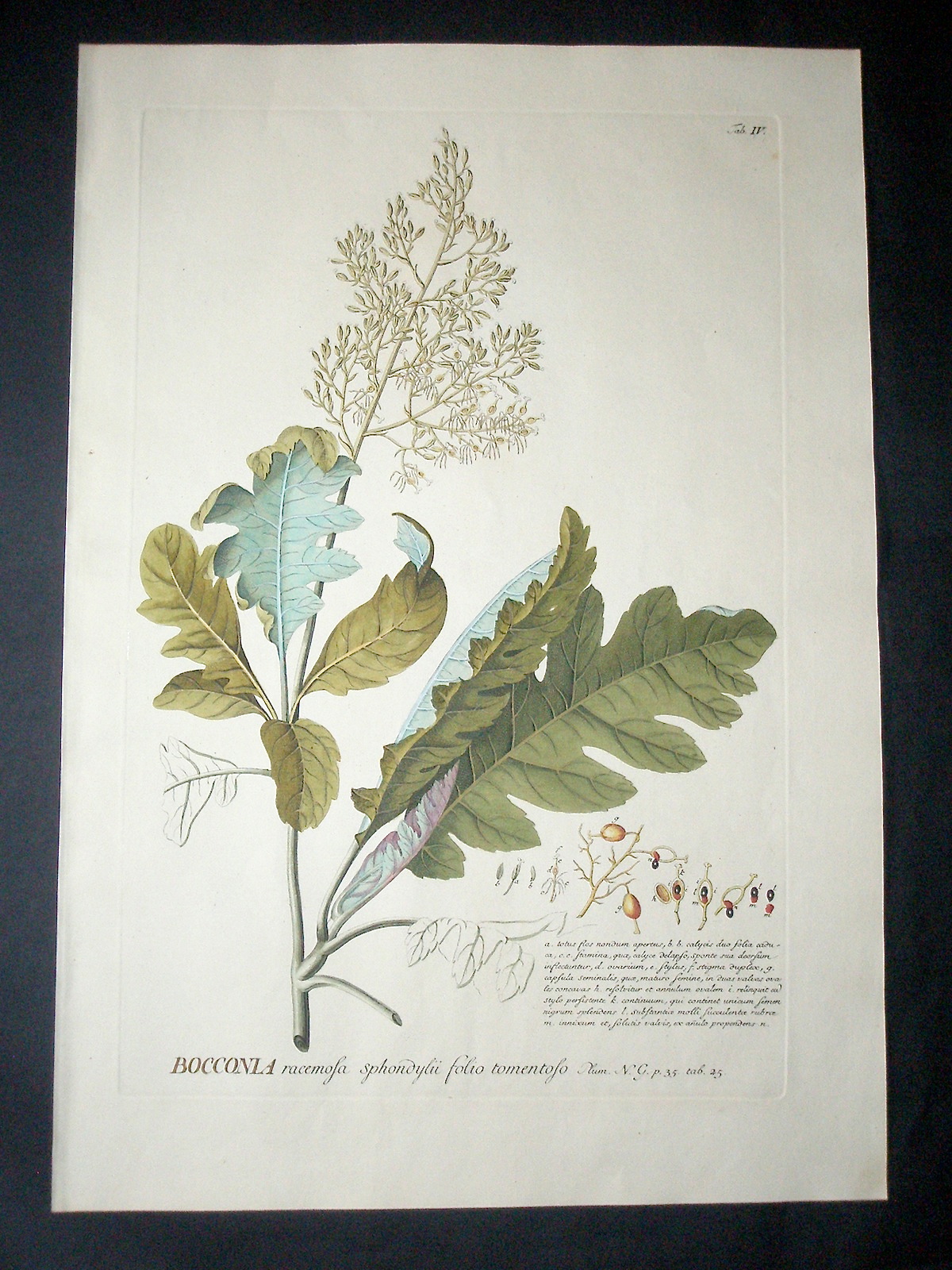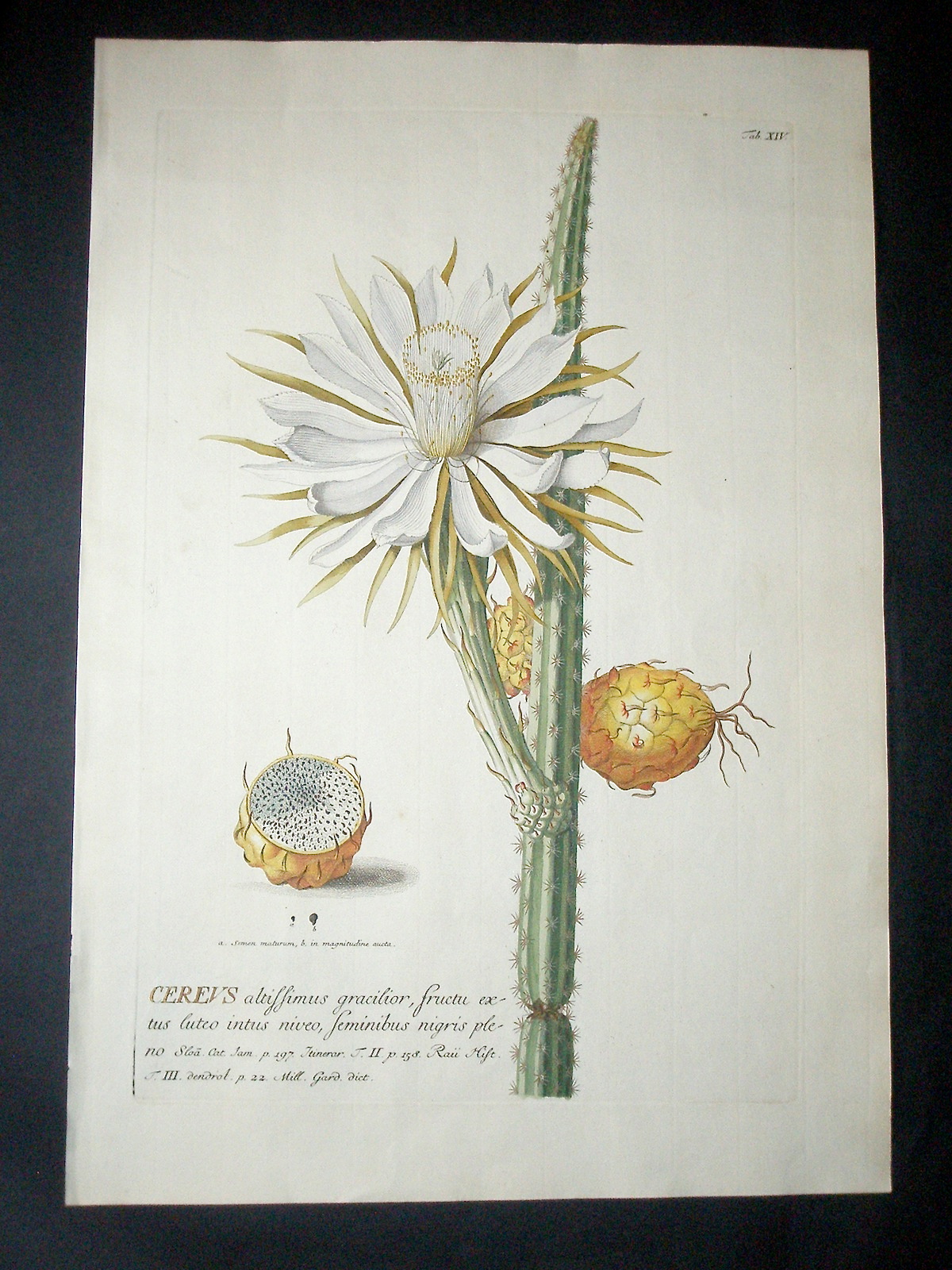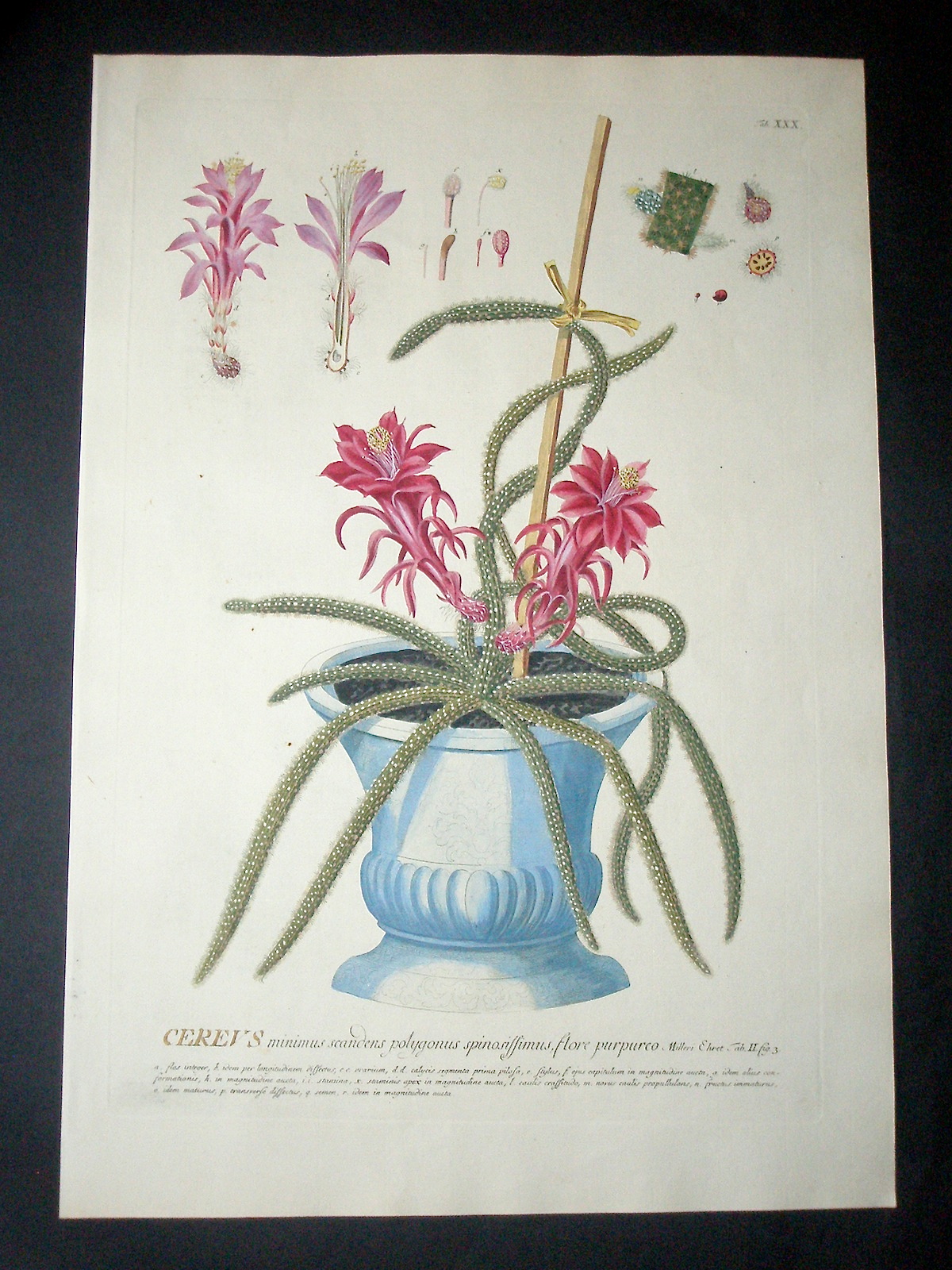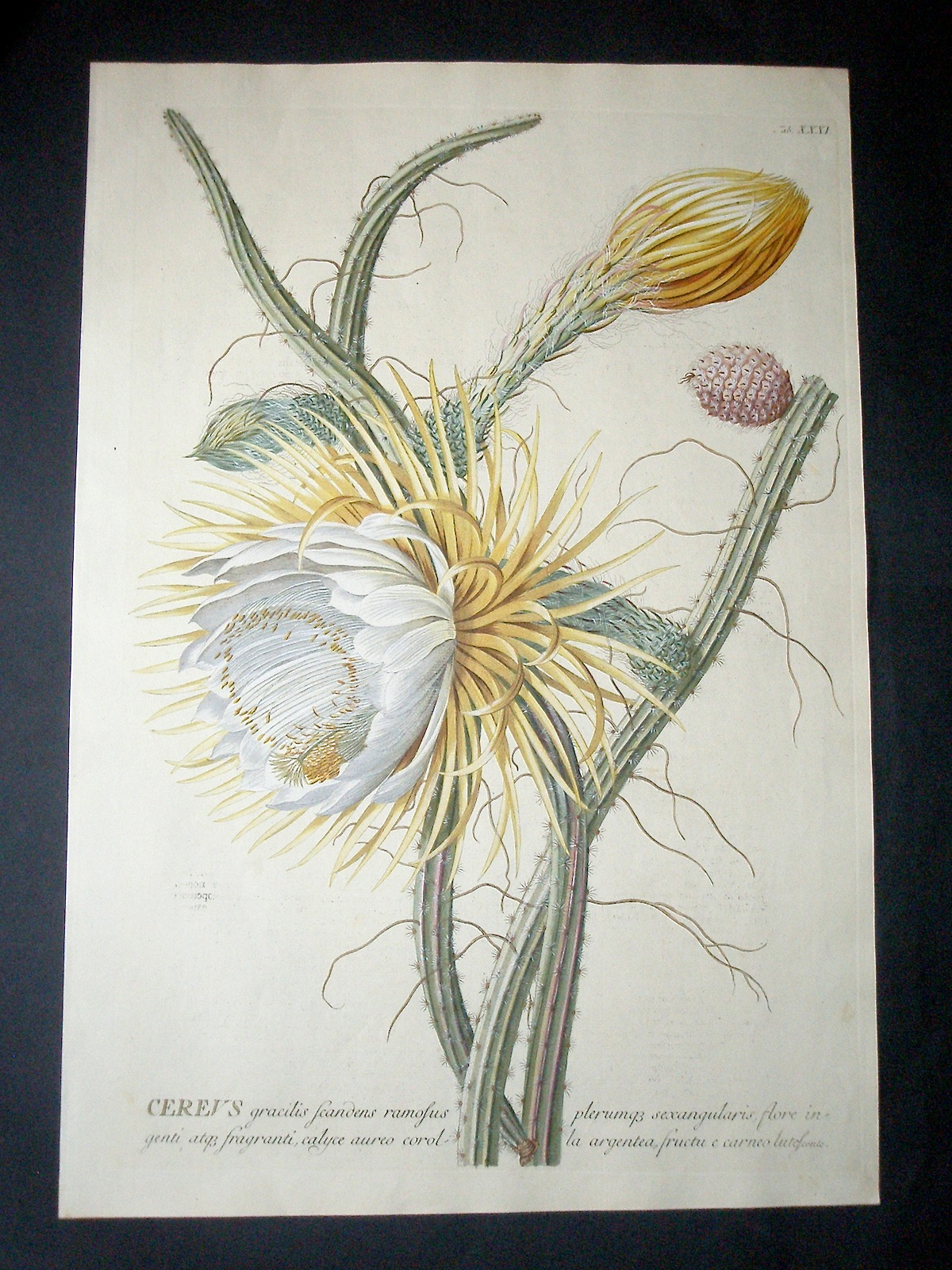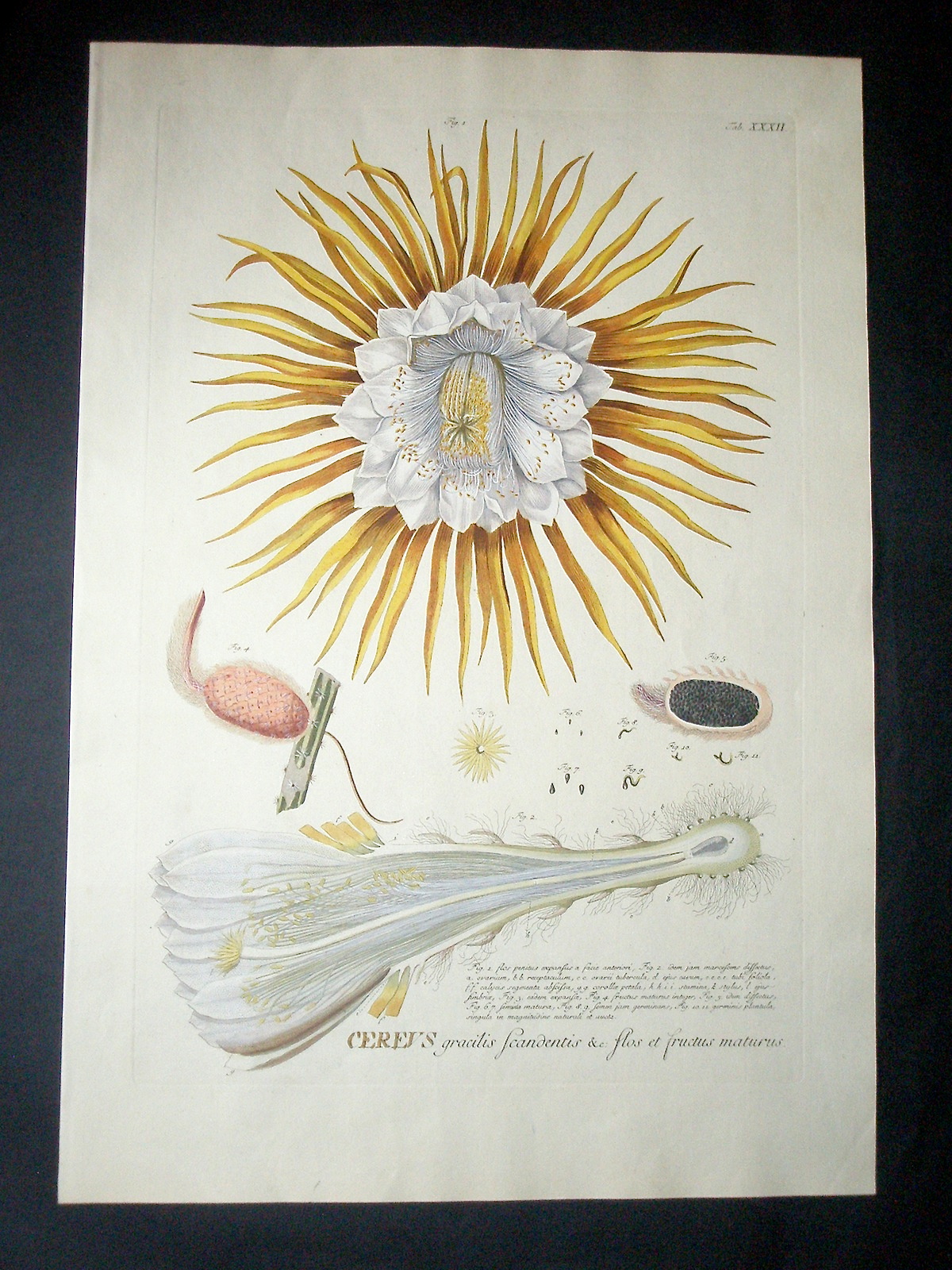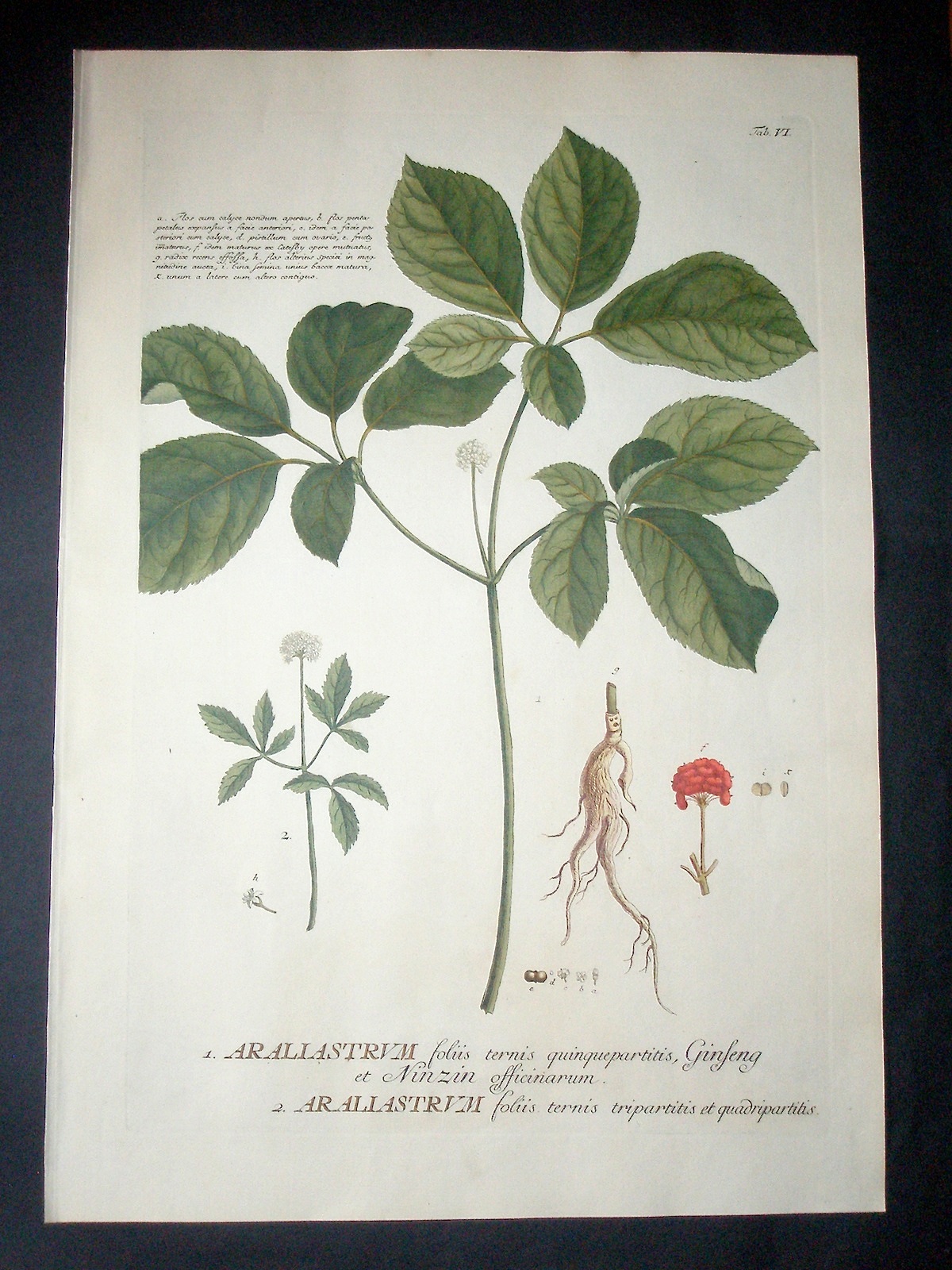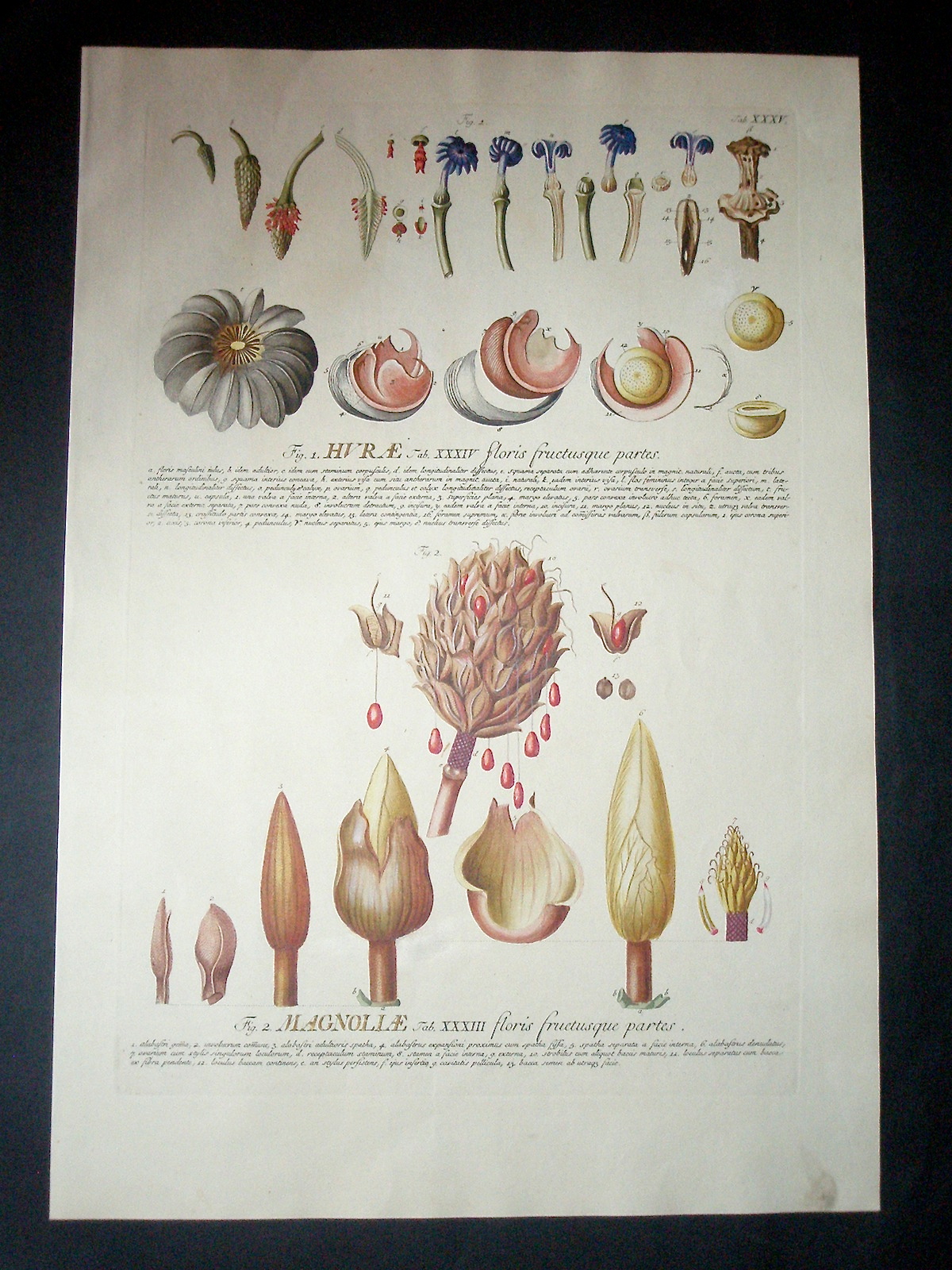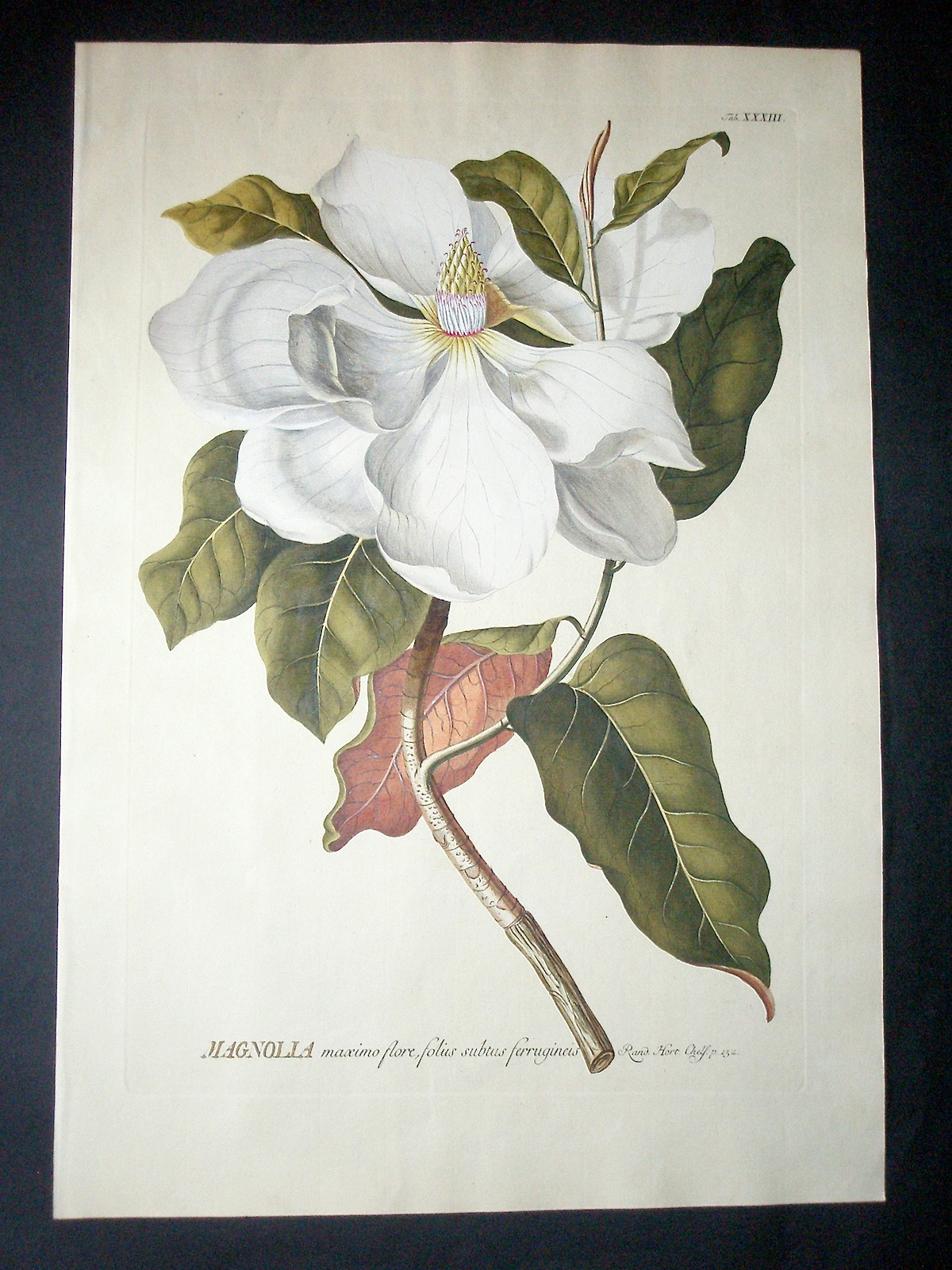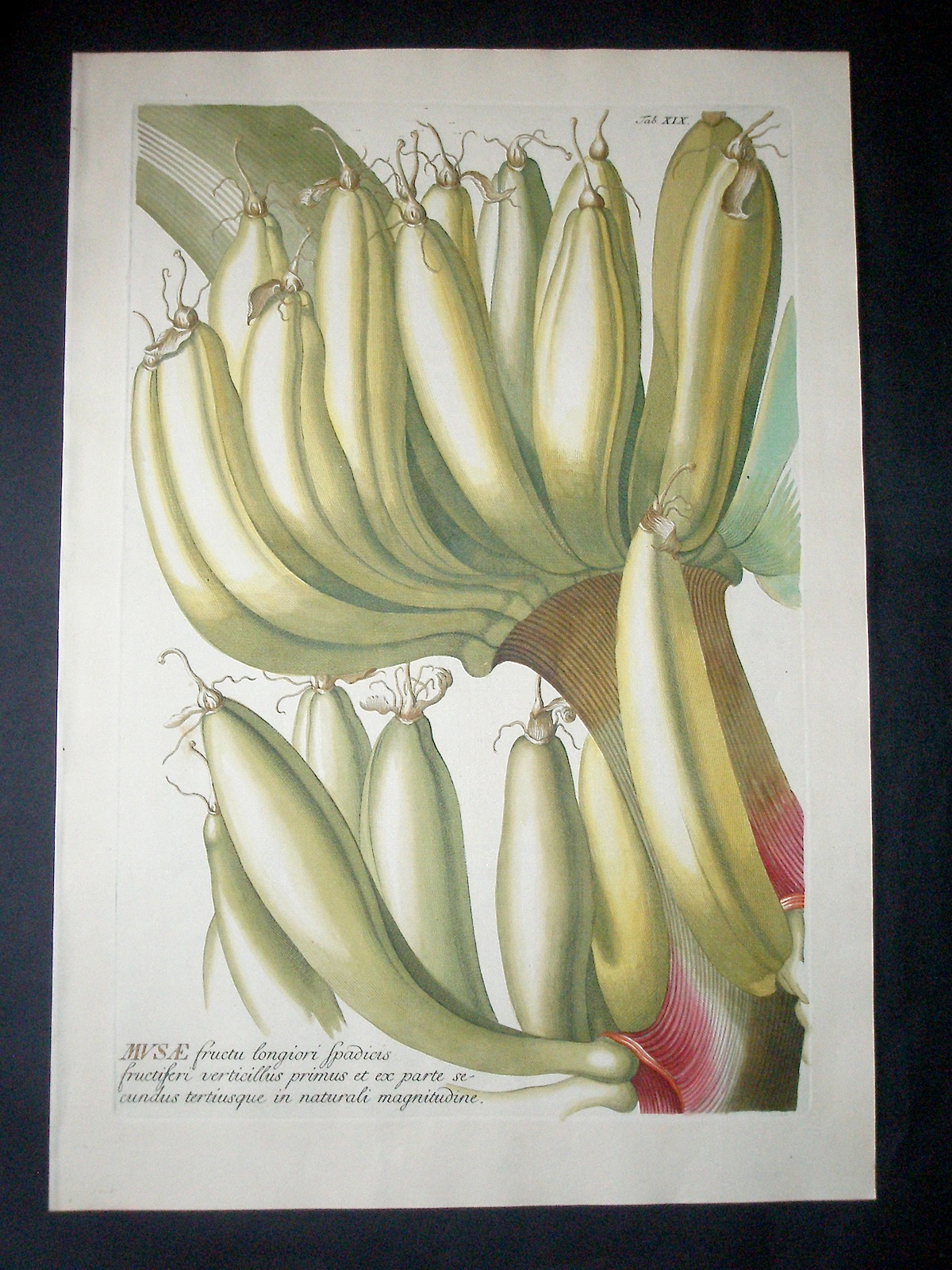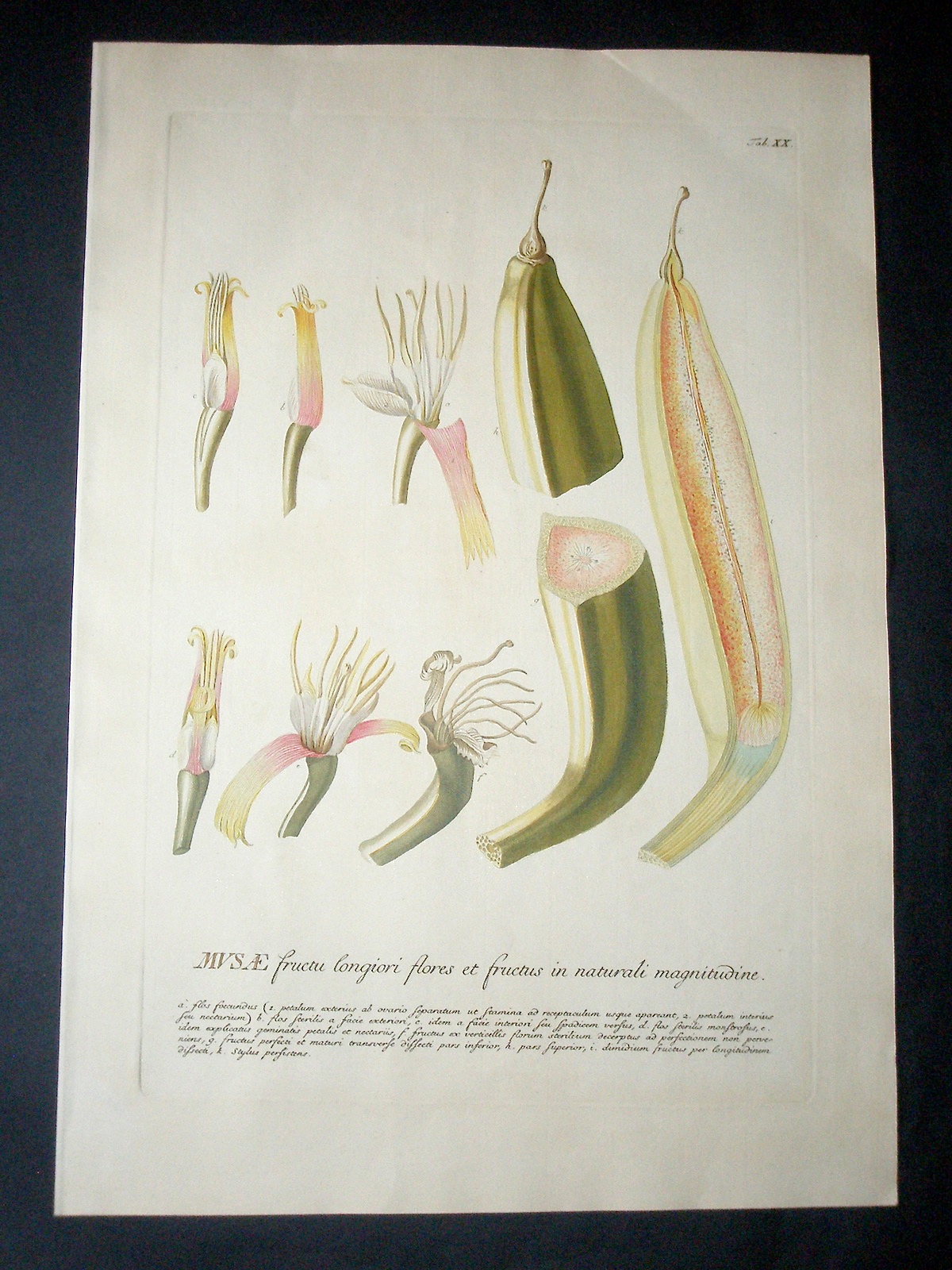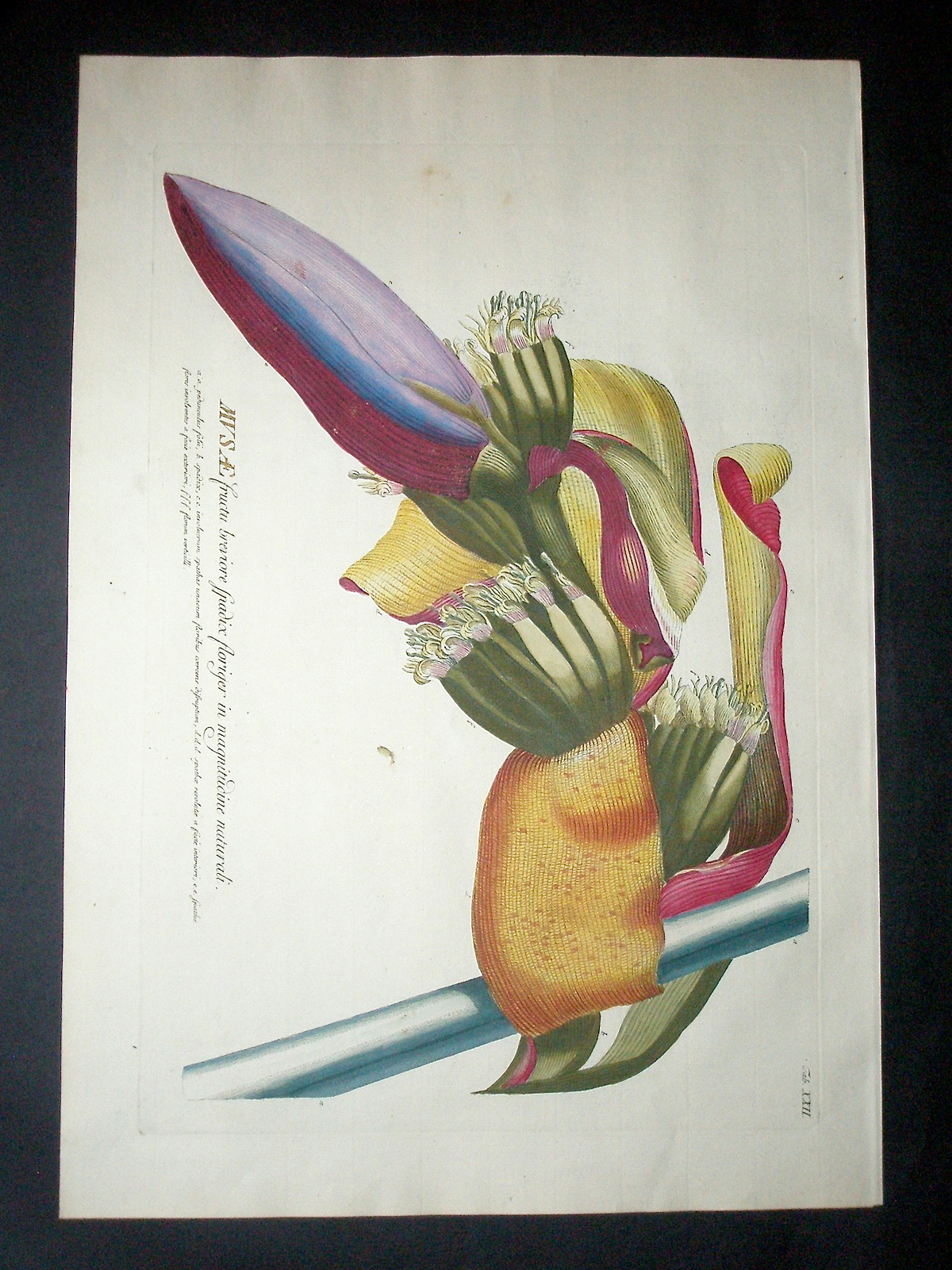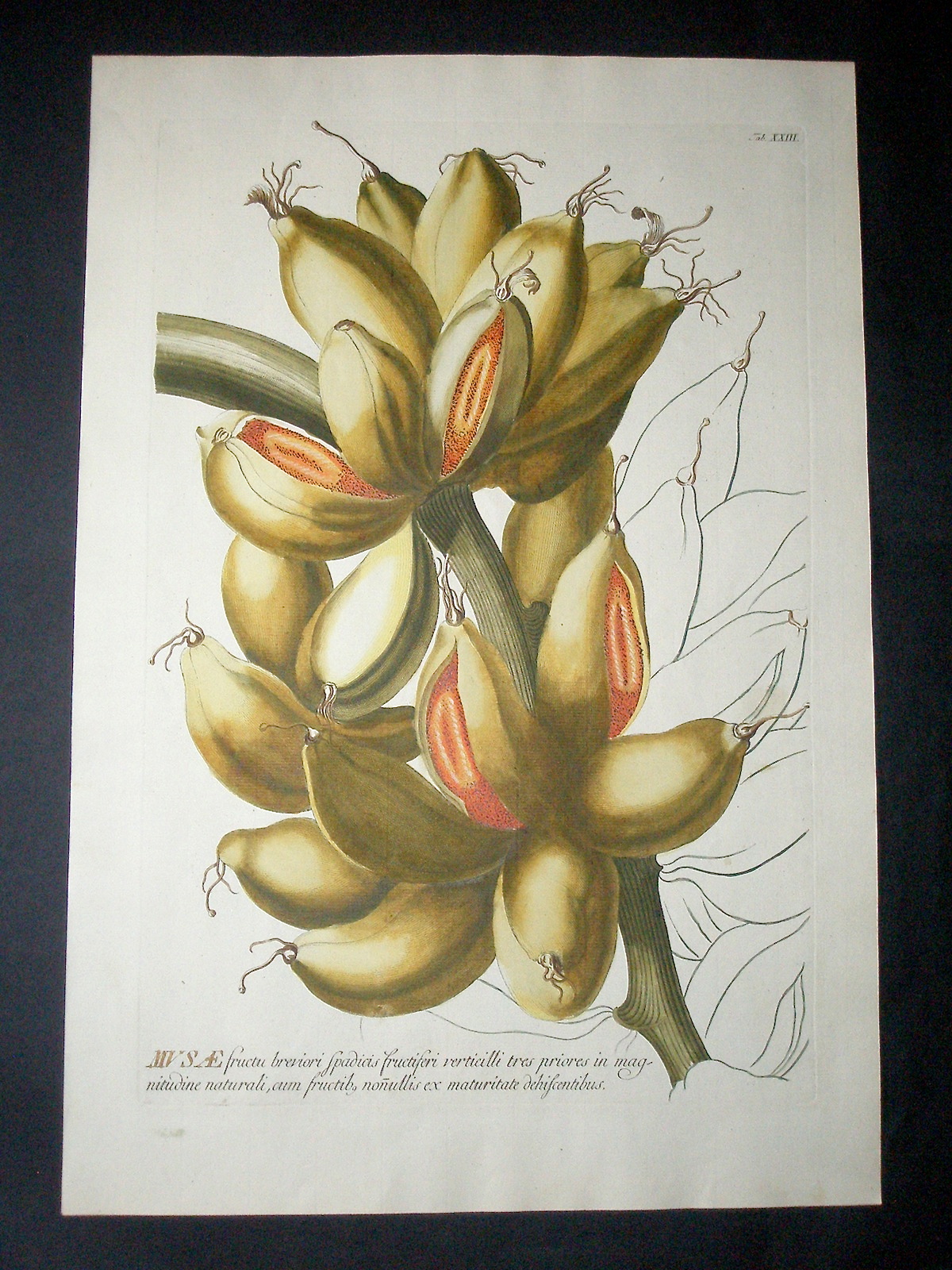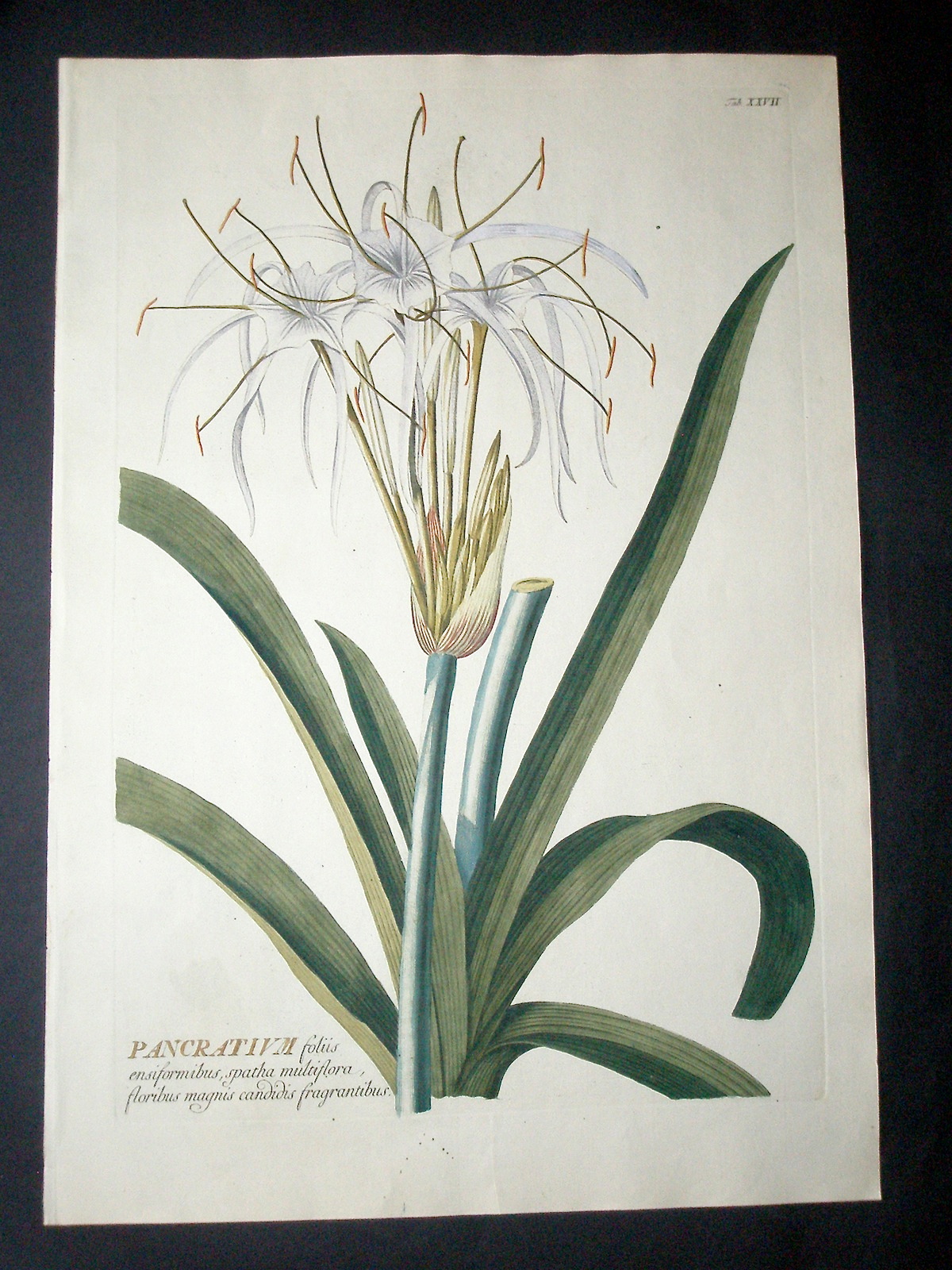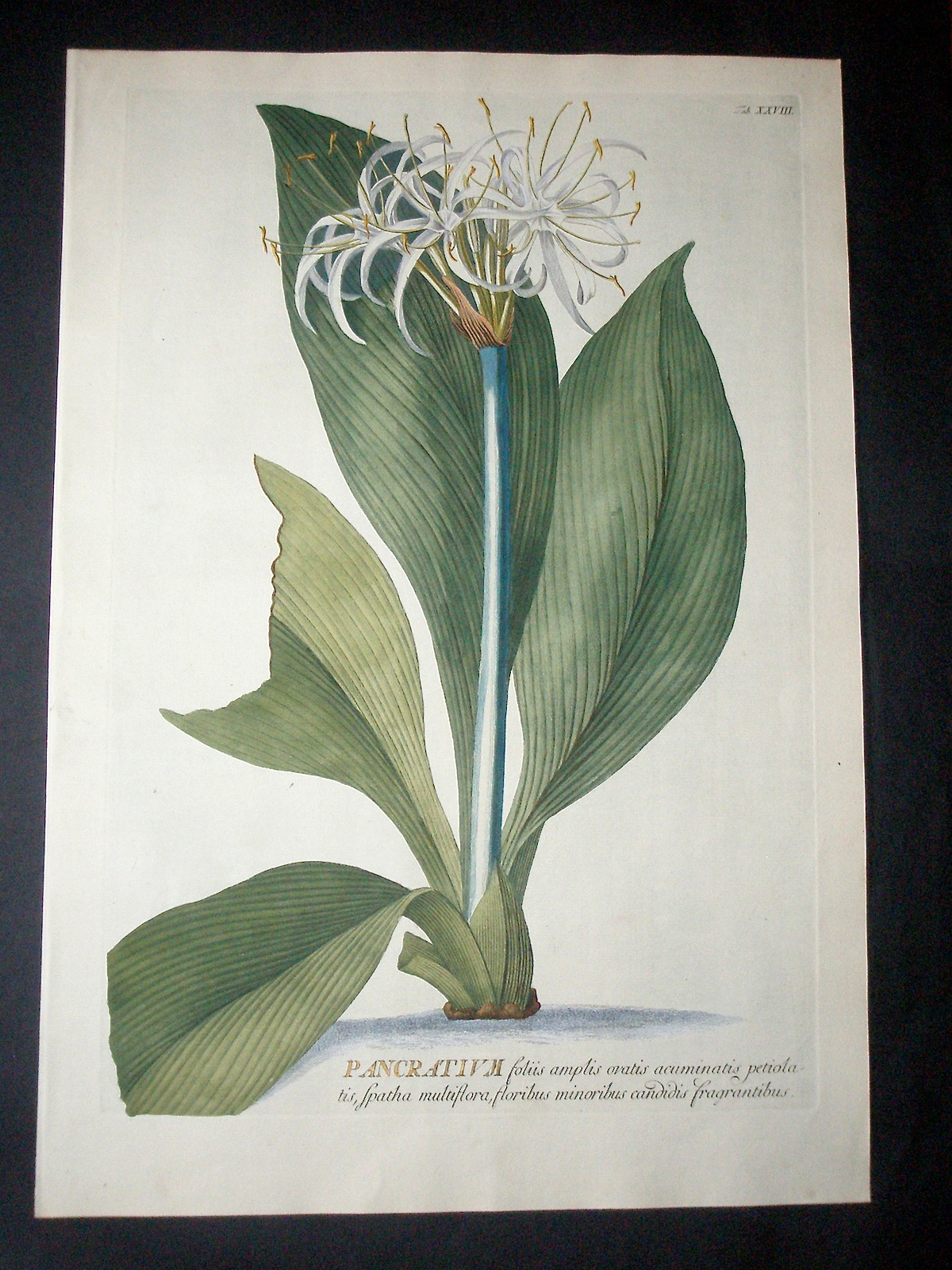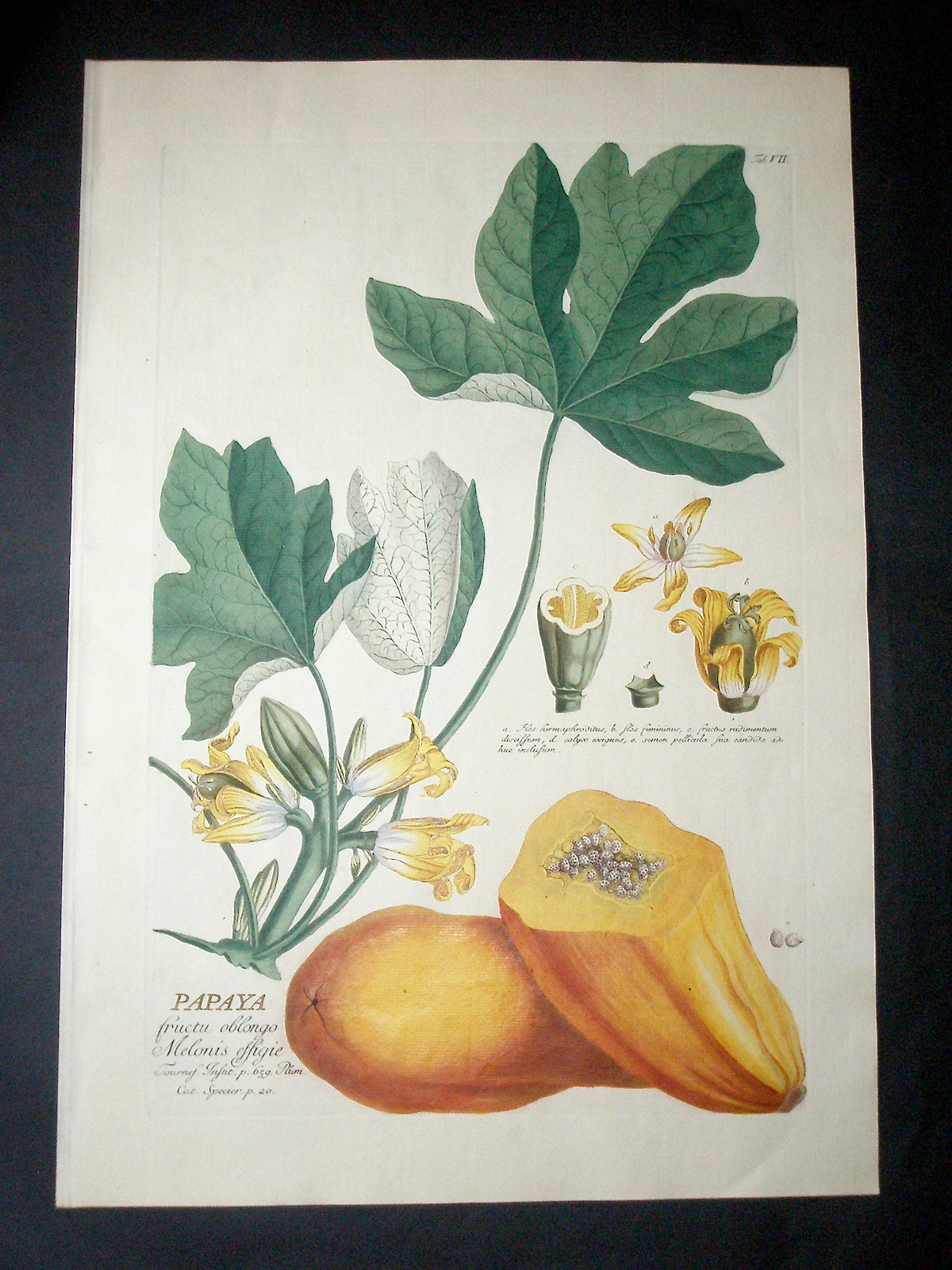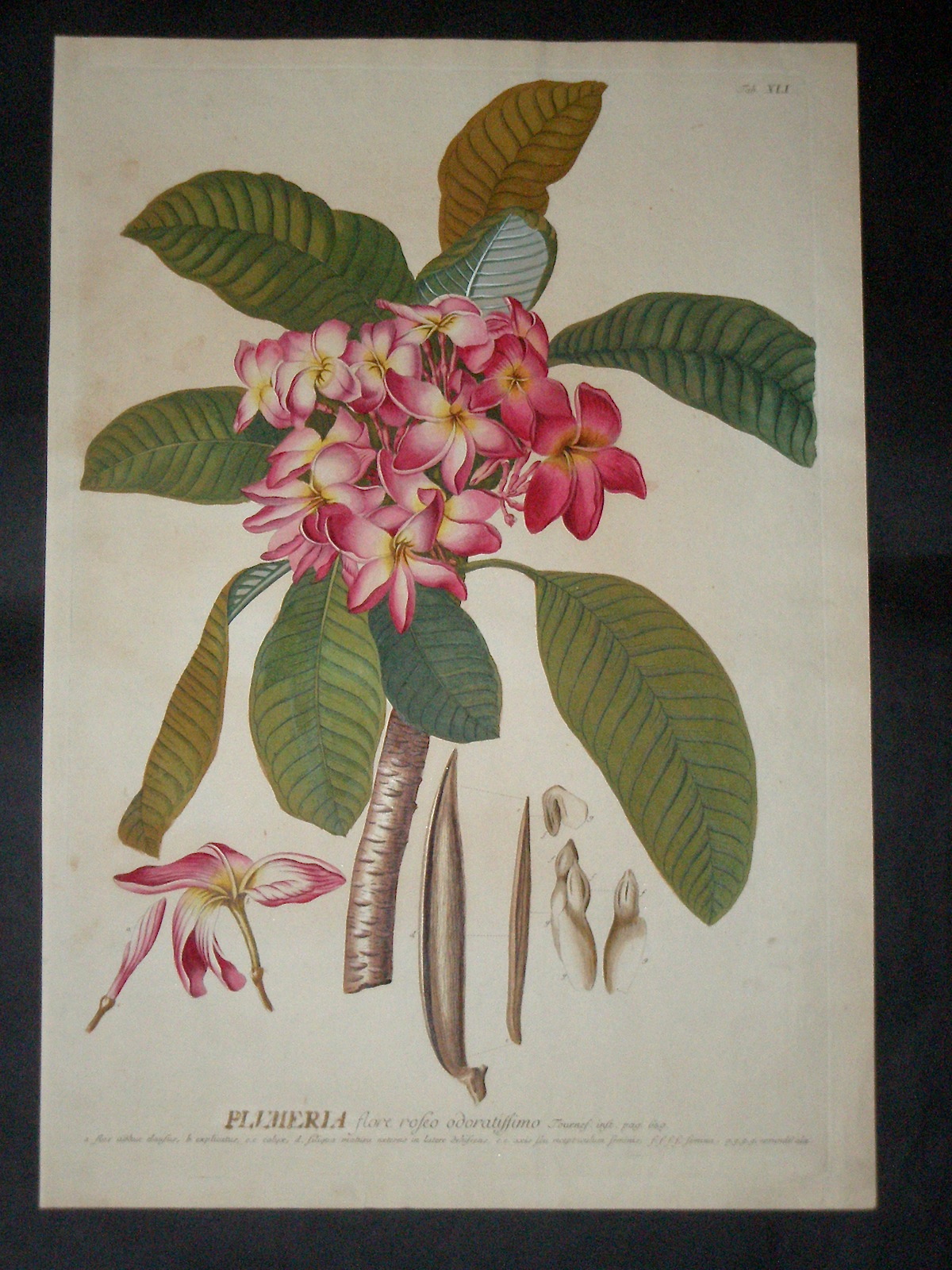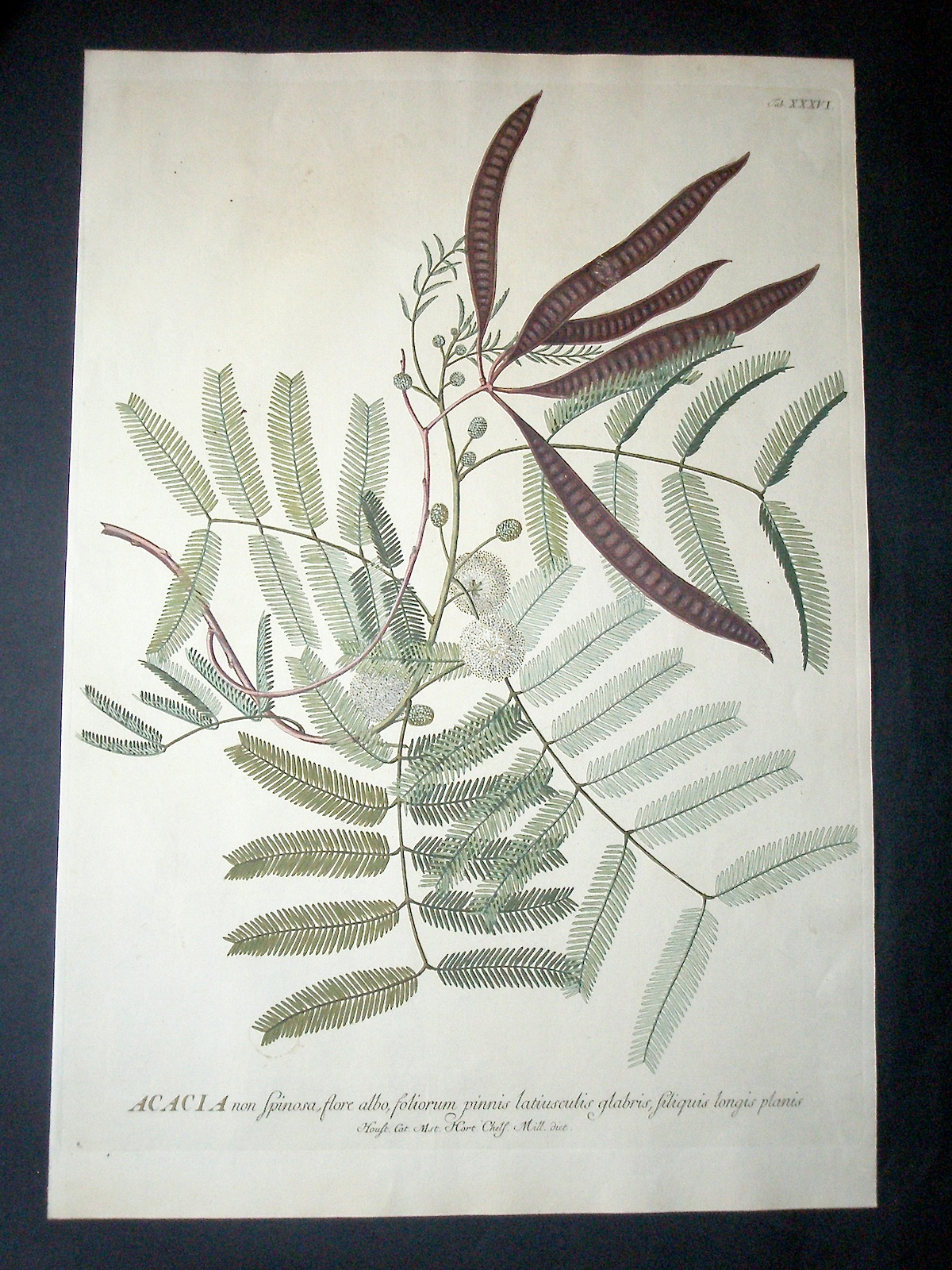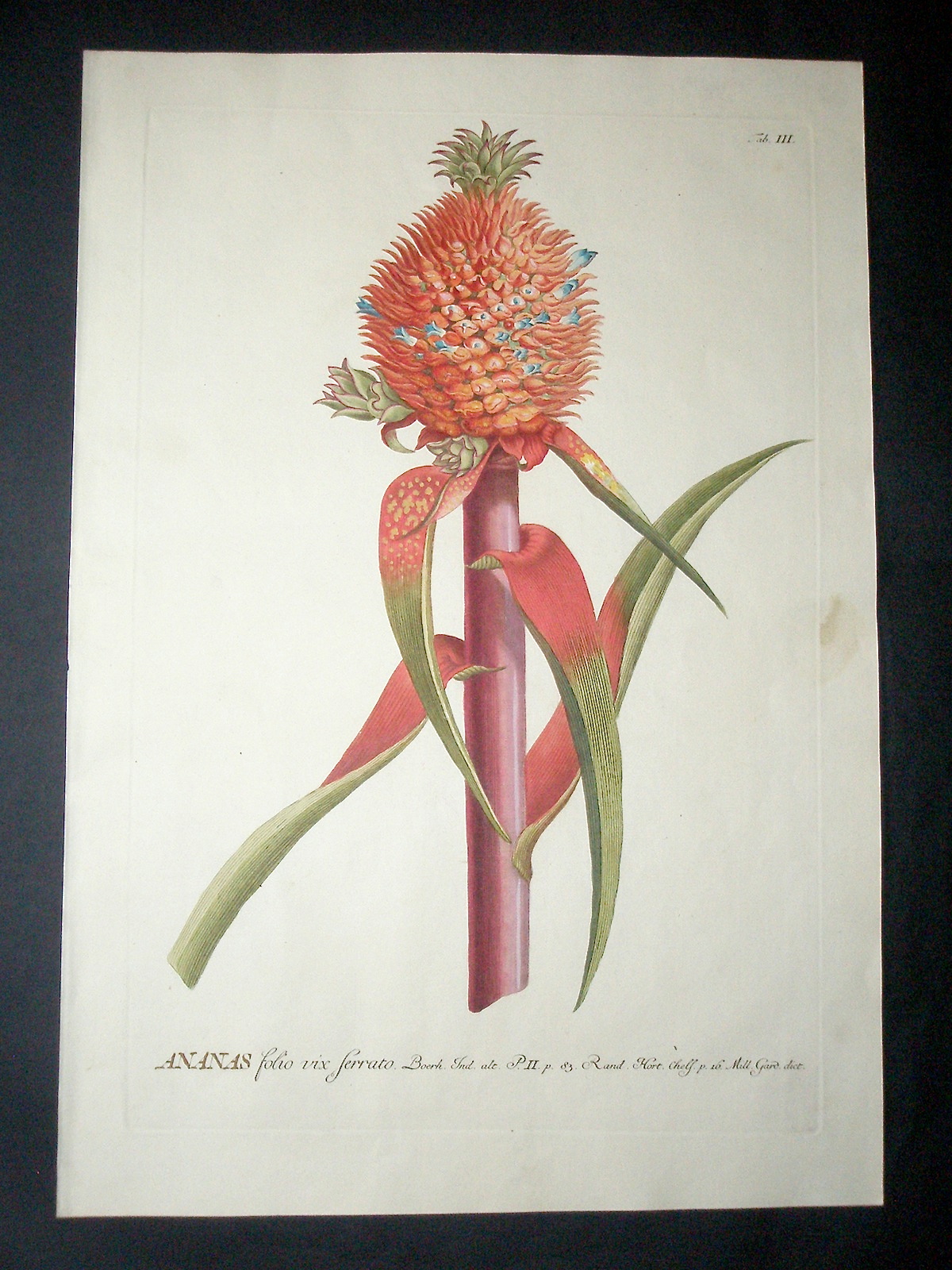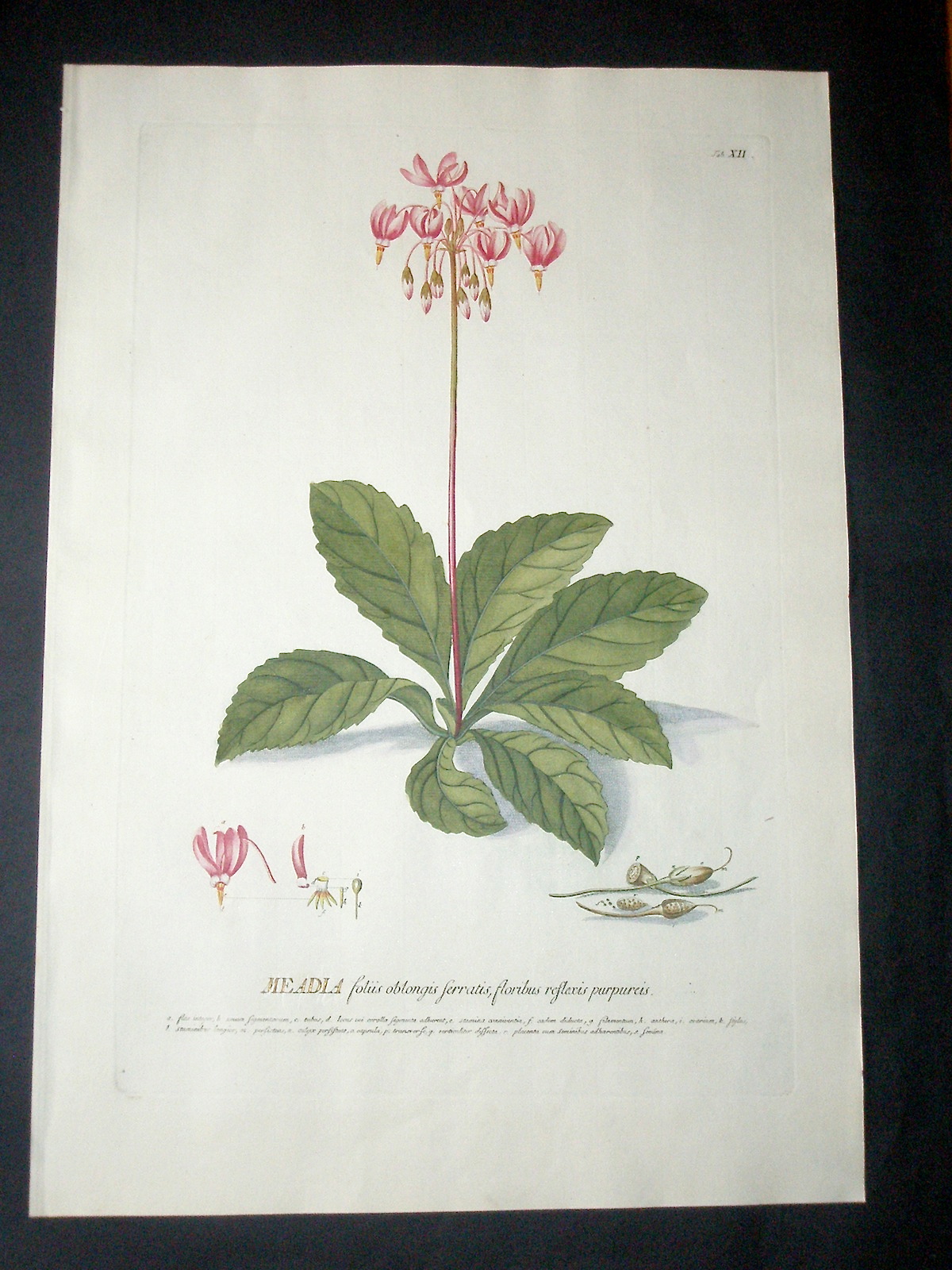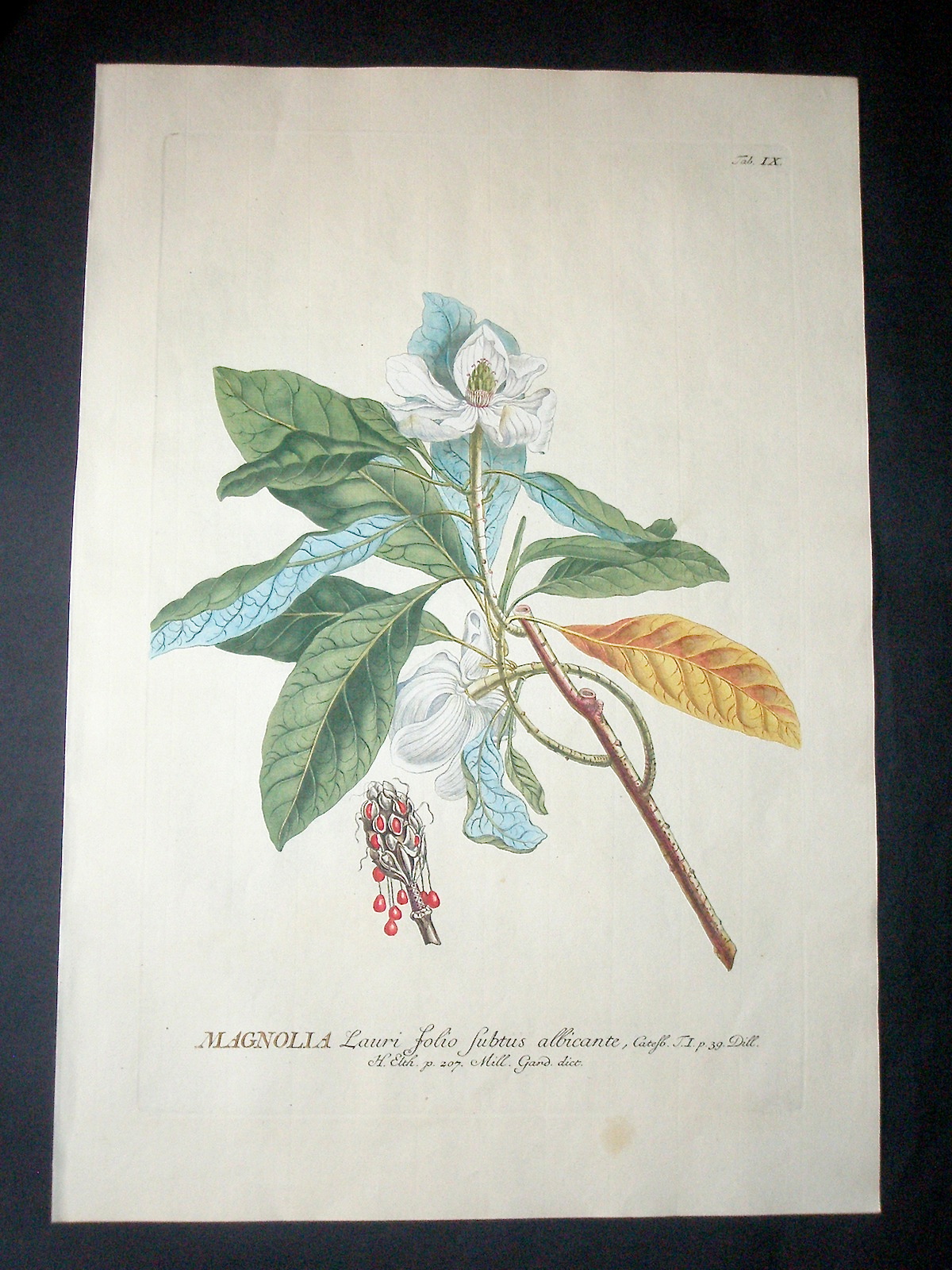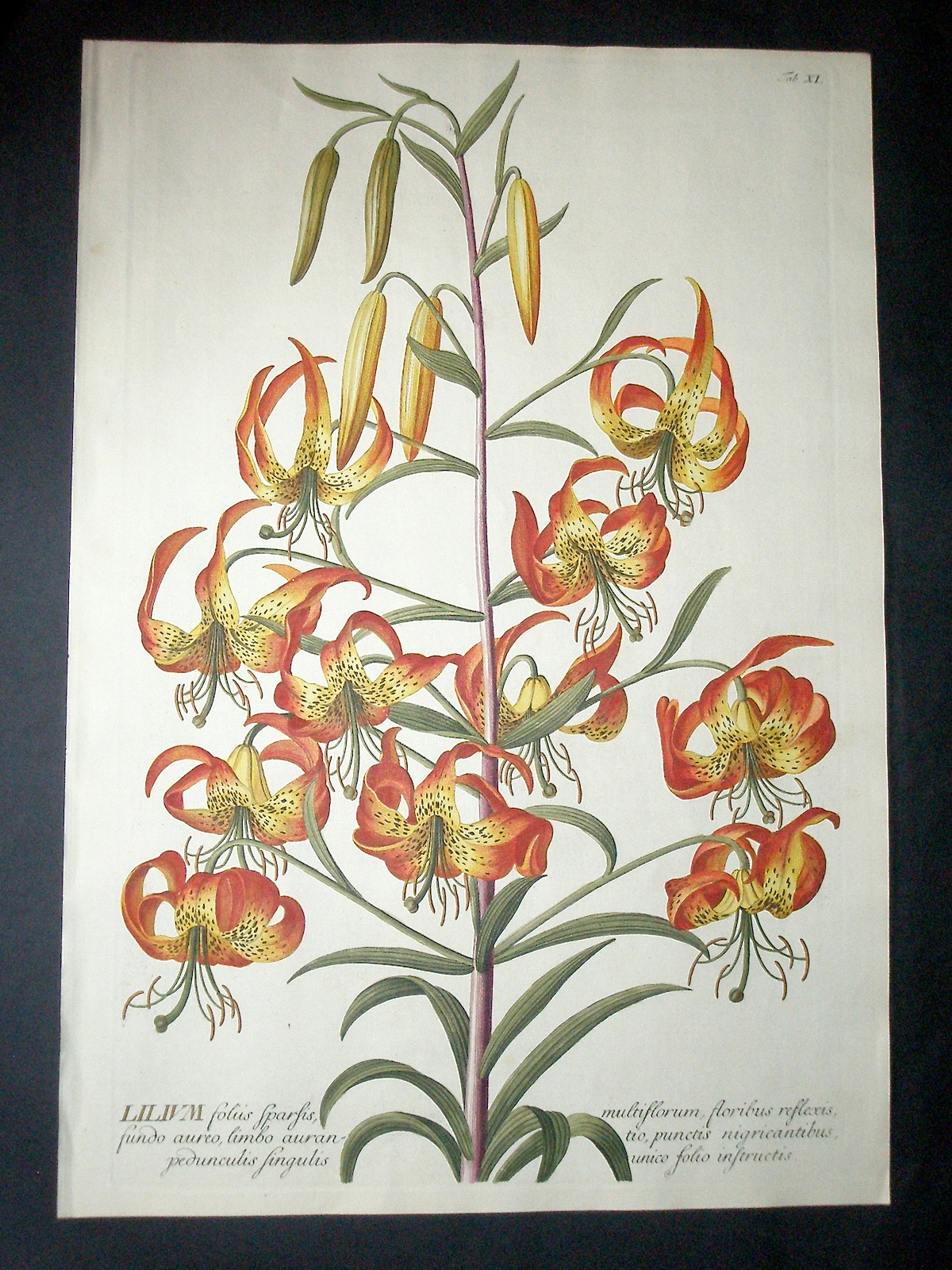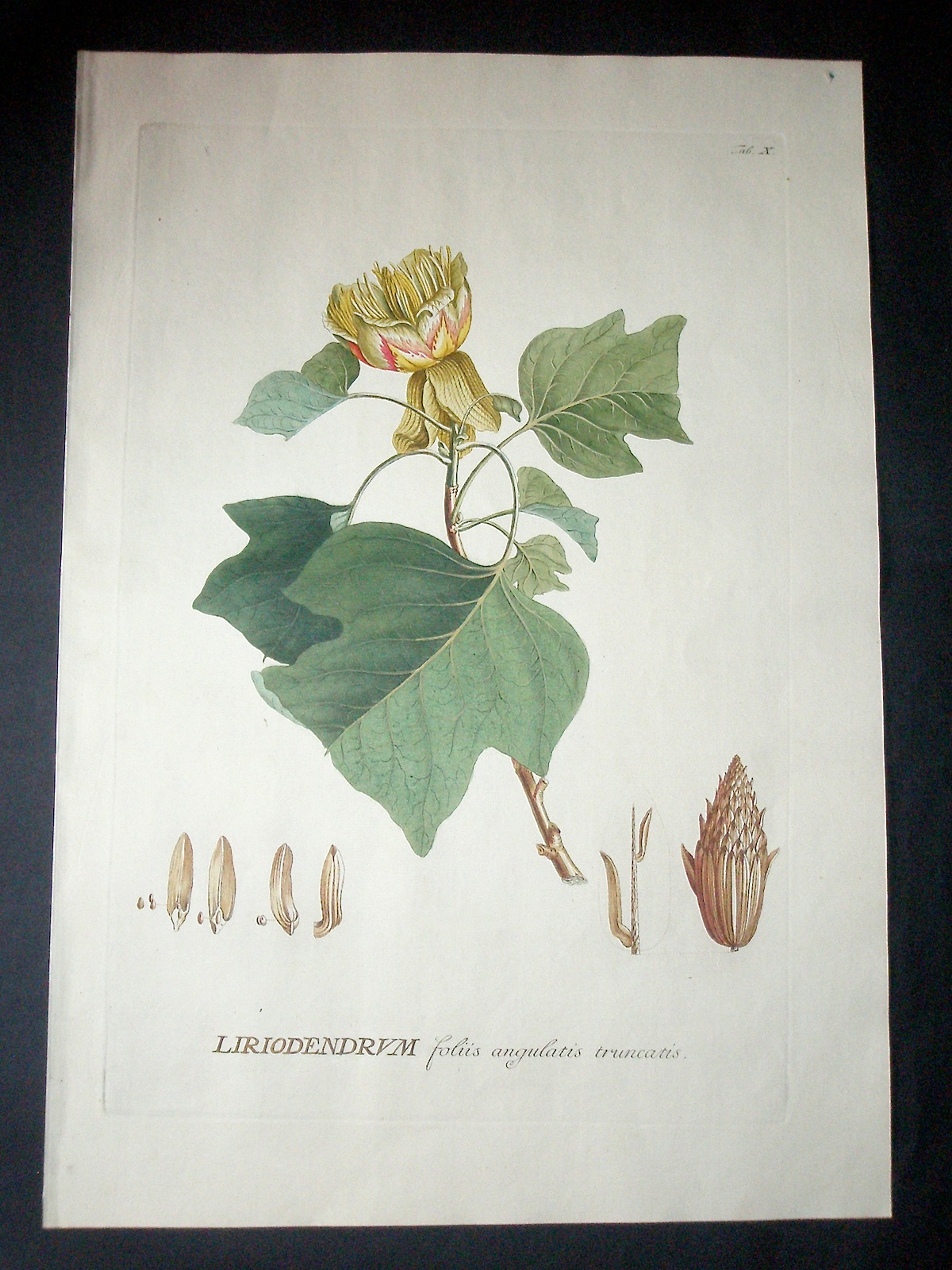
Antique Prints - Flowers - Ehret - Celandine - Pl.004
Ehret & Trew - Tree Celandine
EHRET, After George Dionysius (1710-1770)
Tree Celadine
Nuremberg, 1750-1773.
Specifications: Date: 1750-1773. Size: ~13 5/8 x 20 inches. Style: Hand coloured copperplate engraving. Condition: Excellent
A very fine image from Trew's 'Plantae Selectae', one of the greatest of all eighteenth-century botanical books, drawn by the greatest of eighteenth-century botanical artists, George Dionysius Ehret. Linnaeus, wrote to Trew, in Latin, that "The miracles of our century in the natural sciences are your work of Ehret's plants...nothing to equal them was seen in the past or will be in the future".
Christoph Trew, a physician and botanist, had for a number of years been an admirer of Ehret's work. Ehret, a brilliant botanical artist, was unrivalled in his ability to "achieve realism, majesty, ineffable colour, all in one breathtaking look." (Hunt). Born in Heidelberg in 1710, he originally worked as a gardener and practised drawing in his spare time. His artistic abilities led him to the service of a Regensburg banker named Leskenkohl, and it was during this period that Trew met Ehret.
Trew was to remain a friend and patron of Ehret's throughout his life, and by 1742, the germ of what was to become the present publication was already under discussion when Trew wrote to Christian Thran in Carlsruhe "Every year I receive some beautifully painted exotic plants [by Ehret] and have already more than one hundred of them...."
Ehret moved to London in the late 1730s, where he painted the recently introduced exotics at the Chelsea Physic Garden and established himself as a teacher of flower-painting and botany. Discussions about the projected work continued by letter until 1748, when Johann Jacob Haid from Augsburg agreed to produce the engravings from Ehret's drawings.
Gerta Calman Georg Ehret, Flower painter Extraordinary (1977) p.97; Dunthorne 309; Great Flower Books (1990) p.144; Hunt 539; Nissen BBI 1997; Pritzel 9499; Stafleu & Cowan TL2 15.131.

Antique Prints - Flowers - Ehret - Cereus, Cactus - Pl.014
Ehret & Trew - Cereus, Cactus
EHRET, After George Dionysius (1710-1770)
Cereus cactus
Nuremberg, 1750-1773.
Specifications: Date: 1750-1773. Size: ~13 5/8 x 20 inches. Style: Hand coloured copperplate engraving. Condition: Excellent
A very fine image from Trew's 'Plantae Selectae', one of the greatest of all eighteenth-century botanical books, drawn by the greatest of eighteenth-century botanical artists, George Dionysius Ehret. Linnaeus, wrote to Trew, in Latin, that "The miracles of our century in the natural sciences are your work of Ehret's plants...nothing to equal them was seen in the past or will be in the future".
Christoph Trew, a physician and botanist, had for a number of years been an admirer of Ehret's work. Ehret, a brilliant botanical artist, was unrivalled in his ability to "achieve realism, majesty, ineffable colour, all in one breathtaking look." (Hunt). Born in Heidelberg in 1710, he originally worked as a gardener and practised drawing in his spare time. His artistic abilities led him to the service of a Regensburg banker named Leskenkohl, and it was during this period that Trew met Ehret.
Trew was to remain a friend and patron of Ehret's throughout his life, and by 1742, the germ of what was to become the present publication was already under discussion when Trew wrote to Christian Thran in Carlsruhe "Every year I receive some beautifully painted exotic plants [by Ehret] and have already more than one hundred of them...."
Ehret moved to London in the late 1730s, where he painted the recently introduced exotics at the Chelsea Physic Garden and established himself as a teacher of flower-painting and botany. Discussions about the projected work continued by letter until 1748, when Johann Jacob Haid from Augsburg agreed to produce the engravings from Ehret's drawings.
Gerta Calman Georg Ehret, Flower painter Extraordinary (1977) p.97; Dunthorne 309; Great Flower Books (1990) p.144; Hunt 539; Nissen BBI 1997; Pritzel 9499; Stafleu & Cowan TL2 15.131.

Antique Prints - Flowers - Ehret - Cereus, Cactus - Pl.030
Ehret & Trew - Cereus, Cactus
EHRET, After George Dionysius (1710-1770)
Ananas [Pineapple]
Nuremberg, 1750-1773.
Specifications: Date: 1750-1773. Size: ~13 5/8 x 20 inches. Style: Hand coloured copperplate engraving. Condition: Excellent
A very fine image from Trew's 'Plantae Selectae', one of the greatest of all eighteenth-century botanical books, drawn by the greatest of eighteenth-century botanical artists, George Dionysius Ehret. Linnaeus, wrote to Trew, in Latin, that "The miracles of our century in the natural sciences are your work of Ehret's plants...nothing to equal them was seen in the past or will be in the future".
Christoph Trew, a physician and botanist, had for a number of years been an admirer of Ehret's work. Ehret, a brilliant botanical artist, was unrivalled in his ability to "achieve realism, majesty, ineffable colour, all in one breathtaking look." (Hunt). Born in Heidelberg in 1710, he originally worked as a gardener and practised drawing in his spare time. His artistic abilities led him to the service of a Regensburg banker named Leskenkohl, and it was during this period that Trew met Ehret.
Trew was to remain a friend and patron of Ehret's throughout his life, and by 1742, the germ of what was to become the present publication was already under discussion when Trew wrote to Christian Thran in Carlsruhe "Every year I receive some beautifully painted exotic plants [by Ehret] and have already more than one hundred of them...."
Ehret moved to London in the late 1730s, where he painted the recently introduced exotics at the Chelsea Physic Garden and established himself as a teacher of flower-painting and botany. Discussions about the projected work continued by letter until 1748, when Johann Jacob Haid from Augsburg agreed to produce the engravings from Ehret's drawings.
Gerta Calman Georg Ehret, Flower painter Extraordinary (1977) p.97; Dunthorne 309; Great Flower Books (1990) p.144; Hunt 539; Nissen BBI 1997; Pritzel 9499; Stafleu & Cowan TL2 15.131.

Antique Prints - Flowers - Ehret - Cereus, Cactus - Pl.031
Ehret & Trew - Cereus, Cactus
EHRET, After George Dionysius (1710-1770)
Cereus, cactus
Nuremberg, 1750-1773.
Specifications: Date: 1750-1773. Size: ~13 5/8 x 20 inches. Style: Hand coloured copperplate engraving. Condition: Excellent
A very fine image from Trew's 'Plantae Selectae', one of the greatest of all eighteenth-century botanical books, drawn by the greatest of eighteenth-century botanical artists, George Dionysius Ehret. Linnaeus, wrote to Trew, in Latin, that "The miracles of our century in the natural sciences are your work of Ehret's plants...nothing to equal them was seen in the past or will be in the future".
Christoph Trew, a physician and botanist, had for a number of years been an admirer of Ehret's work. Ehret, a brilliant botanical artist, was unrivalled in his ability to "achieve realism, majesty, ineffable colour, all in one breathtaking look." (Hunt). Born in Heidelberg in 1710, he originally worked as a gardener and practised drawing in his spare time. His artistic abilities led him to the service of a Regensburg banker named Leskenkohl, and it was during this period that Trew met Ehret.
Trew was to remain a friend and patron of Ehret's throughout his life, and by 1742, the germ of what was to become the present publication was already under discussion when Trew wrote to Christian Thran in Carlsruhe "Every year I receive some beautifully painted exotic plants [by Ehret] and have already more than one hundred of them...."
Ehret moved to London in the late 1730s, where he painted the recently introduced exotics at the Chelsea Physic Garden and established himself as a teacher of flower-painting and botany. Discussions about the projected work continued by letter until 1748, when Johann Jacob Haid from Augsburg agreed to produce the engravings from Ehret's drawings.
Gerta Calman Georg Ehret, Flower painter Extraordinary (1977) p.97; Dunthorne 309; Great Flower Books (1990) p.144; Hunt 539; Nissen BBI 1997; Pritzel 9499; Stafleu & Cowan TL2 15.131.

Antique Prints - Flowers - Ehret - Cereus, Cactus - Pl.32
Ehret & Trew - Cereus, Cactus
EHRET, After George Dionysius (1710-1770)
Cereus cactus
Nuremberg, 1750-1773.
Specifications: Date: 1750-1773. Size: ~13 5/8 x 20 inches. Style: Hand coloured copperplate engraving. Condition: Excellent
A very fine image from Trew's 'Plantae Selectae', one of the greatest of all eighteenth-century botanical books, drawn by the greatest of eighteenth-century botanical artists, George Dionysius Ehret. Linnaeus, wrote to Trew, in Latin, that "The miracles of our century in the natural sciences are your work of Ehret's plants...nothing to equal them was seen in the past or will be in the future".
Christoph Trew, a physician and botanist, had for a number of years been an admirer of Ehret's work. Ehret, a brilliant botanical artist, was unrivalled in his ability to "achieve realism, majesty, ineffable colour, all in one breathtaking look." (Hunt). Born in Heidelberg in 1710, he originally worked as a gardener and practised drawing in his spare time. His artistic abilities led him to the service of a Regensburg banker named Leskenkohl, and it was during this period that Trew met Ehret.
Trew was to remain a friend and patron of Ehret's throughout his life, and by 1742, the germ of what was to become the present publication was already under discussion when Trew wrote to Christian Thran in Carlsruhe "Every year I receive some beautifully painted exotic plants [by Ehret] and have already more than one hundred of them...."
Ehret moved to London in the late 1730s, where he painted the recently introduced exotics at the Chelsea Physic Garden and established himself as a teacher of flower-painting and botany. Discussions about the projected work continued by letter until 1748, when Johann Jacob Haid from Augsburg agreed to produce the engravings from Ehret's drawings.
Gerta Calman Georg Ehret, Flower painter Extraordinary (1977) p.97; Dunthorne 309; Great Flower Books (1990) p.144; Hunt 539; Nissen BBI 1997; Pritzel 9499; Stafleu & Cowan TL2 15.131.

Antique Prints - Flowers - Ehret - Ginseng - Pl.006
Ehret & Trew - Ginseng
EHRET, After George Dionysius (1710-1770)
Ginseng
Nuremberg, 1750-1773.
Specifications: Date: 1750-1773. Size: ~13 5/8 x 20 inches. Style: Hand coloured copperplate engraving. Condition: Excellent
A very fine image from Trew's 'Plantae Selectae', one of the greatest of all eighteenth-century botanical books, drawn by the greatest of eighteenth-century botanical artists, George Dionysius Ehret. Linnaeus, wrote to Trew, in Latin, that "The miracles of our century in the natural sciences are your work of Ehret's plants...nothing to equal them was seen in the past or will be in the future".
Christoph Trew, a physician and botanist, had for a number of years been an admirer of Ehret's work. Ehret, a brilliant botanical artist, was unrivalled in his ability to "achieve realism, majesty, ineffable colour, all in one breathtaking look." (Hunt). Born in Heidelberg in 1710, he originally worked as a gardener and practised drawing in his spare time. His artistic abilities led him to the service of a Regensburg banker named Leskenkohl, and it was during this period that Trew met Ehret.
Trew was to remain a friend and patron of Ehret's throughout his life, and by 1742, the germ of what was to become the present publication was already under discussion when Trew wrote to Christian Thran in Carlsruhe "Every year I receive some beautifully painted exotic plants [by Ehret] and have already more than one hundred of them...."
Ehret moved to London in the late 1730s, where he painted the recently introduced exotics at the Chelsea Physic Garden and established himself as a teacher of flower-painting and botany. Discussions about the projected work continued by letter until 1748, when Johann Jacob Haid from Augsburg agreed to produce the engravings from Ehret's drawings.
Gerta Calman Georg Ehret, Flower painter Extraordinary (1977) p.97; Dunthorne 309; Great Flower Books (1990) p.144; Hunt 539; Nissen BBI 1997; Pritzel 9499; Stafleu & Cowan TL2 15.131.

Antique Prints - Flowers - Ehret - Lilio-Narcissus - Pl.013
Ehret & Trew - Lilio-Narcissus
EHRET, After George Dionysius (1710-1770)
Lilio-Narcissus
Nuremberg, 1750-1773.
Specifications: Date: 1750-1773. Size: ~13 5/8 x 20 inches. Style: Hand coloured copperplate engraving. Condition: Excellent
A very fine image from Trew's 'Plantae Selectae', one of the greatest of all eighteenth-century botanical books, drawn by the greatest of eighteenth-century botanical artists, George Dionysius Ehret. Linnaeus, wrote to Trew, in Latin, that "The miracles of our century in the natural sciences are your work of Ehret's plants...nothing to equal them was seen in the past or will be in the future".
Christoph Trew, a physician and botanist, had for a number of years been an admirer of Ehret's work. Ehret, a brilliant botanical artist, was unrivalled in his ability to "achieve realism, majesty, ineffable colour, all in one breathtaking look." (Hunt). Born in Heidelberg in 1710, he originally worked as a gardener and practised drawing in his spare time. His artistic abilities led him to the service of a Regensburg banker named Leskenkohl, and it was during this period that Trew met Ehret.
Trew was to remain a friend and patron of Ehret's throughout his life, and by 1742, the germ of what was to become the present publication was already under discussion when Trew wrote to Christian Thran in Carlsruhe "Every year I receive some beautifully painted exotic plants [by Ehret] and have already more than one hundred of them...."
Ehret moved to London in the late 1730s, where he painted the recently introduced exotics at the Chelsea Physic Garden and established himself as a teacher of flower-painting and botany. Discussions about the projected work continued by letter until 1748, when Johann Jacob Haid from Augsburg agreed to produce the engravings from Ehret's drawings.
Gerta Calman Georg Ehret, Flower painter Extraordinary (1977) p.97; Dunthorne 309; Great Flower Books (1990) p.144; Hunt 539; Nissen BBI 1997; Pritzel 9499; Stafleu & Cowan TL2 15.131.

Antique Prints - Flowers - Ehret - Magnolia - Pl.035
Ehret & Trew - Magnolia
EHRET, After George Dionysius (1710-1770)
Magnolia
Nuremberg, 1750-1773.
Specifications: Date: 1750-1773. Size: ~13 5/8 x 20 inches. Style: Hand coloured copperplate engraving. Condition: Excellent
A very fine image from Trew's 'Plantae Selectae', one of the greatest of all eighteenth-century botanical books, drawn by the greatest of eighteenth-century botanical artists, George Dionysius Ehret. Linnaeus, wrote to Trew, in Latin, that "The miracles of our century in the natural sciences are your work of Ehret's plants...nothing to equal them was seen in the past or will be in the future".
Christoph Trew, a physician and botanist, had for a number of years been an admirer of Ehret's work. Ehret, a brilliant botanical artist, was unrivalled in his ability to "achieve realism, majesty, ineffable colour, all in one breathtaking look." (Hunt). Born in Heidelberg in 1710, he originally worked as a gardener and practised drawing in his spare time. His artistic abilities led him to the service of a Regensburg banker named Leskenkohl, and it was during this period that Trew met Ehret.
Trew was to remain a friend and patron of Ehret's throughout his life, and by 1742, the germ of what was to become the present publication was already under discussion when Trew wrote to Christian Thran in Carlsruhe "Every year I receive some beautifully painted exotic plants [by Ehret] and have already more than one hundred of them...."
Ehret moved to London in the late 1730s, where he painted the recently introduced exotics at the Chelsea Physic Garden and established himself as a teacher of flower-painting and botany. Discussions about the projected work continued by letter until 1748, when Johann Jacob Haid from Augsburg agreed to produce the engravings from Ehret's drawings.
Gerta Calman Georg Ehret, Flower painter Extraordinary (1977) p.97; Dunthorne 309; Great Flower Books (1990) p.144; Hunt 539; Nissen BBI 1997; Pritzel 9499; Stafleu & Cowan TL2 15.131.

Antique Prints - Flowers - Ehret - Magnolia Gra. - Pl.033
Ehret & Trew - Magnolia Grandiflora
EHRET, After George Dionysius (1710-1770)
Magnolia Grandiflora
Nuremberg, 1750-1773.
Specifications: Date: 1750-1773. Size: ~13 5/8 x 20 inches. Style: Hand coloured copperplate engraving. Condition: Excellent
A very fine image from Trew's 'Plantae Selectae', one of the greatest of all eighteenth-century botanical books, drawn by the greatest of eighteenth-century botanical artists, George Dionysius Ehret. Linnaeus, wrote to Trew, in Latin, that "The miracles of our century in the natural sciences are your work of Ehret's plants...nothing to equal them was seen in the past or will be in the future".
Christoph Trew, a physician and botanist, had for a number of years been an admirer of Ehret's work. Ehret, a brilliant botanical artist, was unrivalled in his ability to "achieve realism, majesty, ineffable colour, all in one breathtaking look." (Hunt). Born in Heidelberg in 1710, he originally worked as a gardener and practised drawing in his spare time. His artistic abilities led him to the service of a Regensburg banker named Leskenkohl, and it was during this period that Trew met Ehret.
Trew was to remain a friend and patron of Ehret's throughout his life, and by 1742, the germ of what was to become the present publication was already under discussion when Trew wrote to Christian Thran in Carlsruhe "Every year I receive some beautifully painted exotic plants [by Ehret] and have already more than one hundred of them...."
Ehret moved to London in the late 1730s, where he painted the recently introduced exotics at the Chelsea Physic Garden and established himself as a teacher of flower-painting and botany. Discussions about the projected work continued by letter until 1748, when Johann Jacob Haid from Augsburg agreed to produce the engravings from Ehret's drawings.
Gerta Calman Georg Ehret, Flower painter Extraordinary (1977) p.97; Dunthorne 309; Great Flower Books (1990) p.144; Hunt 539; Nissen BBI 1997; Pritzel 9499; Stafleu & Cowan TL2 15.131.

Antique Prints - Flowers - Ehret - Musa Banana - Pl.019
Ehret & Trew - Musa Banana
EHRET, After George Dionysius (1710-1770)
Musa banana
Nuremberg, 1750-1773.
Specifications: Date: 1750-1773. Size: ~13 5/8 x 20 inches. Style: Hand coloured copperplate engraving. Condition: Excellent
A very fine image from Trew's 'Plantae Selectae', one of the greatest of all eighteenth-century botanical books, drawn by the greatest of eighteenth-century botanical artists, George Dionysius Ehret. Linnaeus, wrote to Trew, in Latin, that "The miracles of our century in the natural sciences are your work of Ehret's plants...nothing to equal them was seen in the past or will be in the future".
Christoph Trew, a physician and botanist, had for a number of years been an admirer of Ehret's work. Ehret, a brilliant botanical artist, was unrivalled in his ability to "achieve realism, majesty, ineffable colour, all in one breathtaking look." (Hunt). Born in Heidelberg in 1710, he originally worked as a gardener and practised drawing in his spare time. His artistic abilities led him to the service of a Regensburg banker named Leskenkohl, and it was during this period that Trew met Ehret.
Trew was to remain a friend and patron of Ehret's throughout his life, and by 1742, the germ of what was to become the present publication was already under discussion when Trew wrote to Christian Thran in Carlsruhe "Every year I receive some beautifully painted exotic plants [by Ehret] and have already more than one hundred of them...."
Ehret moved to London in the late 1730s, where he painted the recently introduced exotics at the Chelsea Physic Garden and established himself as a teacher of flower-painting and botany. Discussions about the projected work continued by letter until 1748, when Johann Jacob Haid from Augsburg agreed to produce the engravings from Ehret's drawings.
Gerta Calman Georg Ehret, Flower painter Extraordinary (1977) p.97; Dunthorne 309; Great Flower Books (1990) p.144; Hunt 539; Nissen BBI 1997; Pritzel 9499; Stafleu & Cowan TL2 15.131.

Antique Prints - Flowers - Ehret - Musa Banana - Pl.020
Ehret & Trew - Musa Banana
EHRET, After George Dionysius (1710-1770)
Musa Banana
Nuremberg, 1750-1773.
Specifications: Date: 1750-1773. Size: ~13 5/8 x 20 inches. Style: Hand coloured copperplate engraving. Condition: Excellent
A very fine image from Trew's 'Plantae Selectae', one of the greatest of all eighteenth-century botanical books, drawn by the greatest of eighteenth-century botanical artists, George Dionysius Ehret. Linnaeus, wrote to Trew, in Latin, that "The miracles of our century in the natural sciences are your work of Ehret's plants...nothing to equal them was seen in the past or will be in the future".
Christoph Trew, a physician and botanist, had for a number of years been an admirer of Ehret's work. Ehret, a brilliant botanical artist, was unrivalled in his ability to "achieve realism, majesty, ineffable colour, all in one breathtaking look." (Hunt). Born in Heidelberg in 1710, he originally worked as a gardener and practised drawing in his spare time. His artistic abilities led him to the service of a Regensburg banker named Leskenkohl, and it was during this period that Trew met Ehret.
Trew was to remain a friend and patron of Ehret's throughout his life, and by 1742, the germ of what was to become the present publication was already under discussion when Trew wrote to Christian Thran in Carlsruhe "Every year I receive some beautifully painted exotic plants [by Ehret] and have already more than one hundred of them...."
Ehret moved to London in the late 1730s, where he painted the recently introduced exotics at the Chelsea Physic Garden and established himself as a teacher of flower-painting and botany. Discussions about the projected work continued by letter until 1748, when Johann Jacob Haid from Augsburg agreed to produce the engravings from Ehret's drawings.
Gerta Calman Georg Ehret, Flower painter Extraordinary (1977) p.97; Dunthorne 309; Great Flower Books (1990) p.144; Hunt 539; Nissen BBI 1997; Pritzel 9499; Stafleu & Cowan TL2 15.131.

Antique Prints - Flowers - Ehret - Musa Banana - Pl.022
Ehret & Trew - Musa Banana
EHRET, After George Dionysius (1710-1770)
Musa Banana
Nuremberg, 1750-1773.
Specifications: Date: 1750-1773. Size: ~13 5/8 x 20 inches. Style: Hand coloured copperplate engraving. Condition: Excellent
A very fine image from Trew's 'Plantae Selectae', one of the greatest of all eighteenth-century botanical books, drawn by the greatest of eighteenth-century botanical artists, George Dionysius Ehret. Linnaeus, wrote to Trew, in Latin, that "The miracles of our century in the natural sciences are your work of Ehret's plants...nothing to equal them was seen in the past or will be in the future".
Christoph Trew, a physician and botanist, had for a number of years been an admirer of Ehret's work. Ehret, a brilliant botanical artist, was unrivalled in his ability to "achieve realism, majesty, ineffable colour, all in one breathtaking look." (Hunt). Born in Heidelberg in 1710, he originally worked as a gardener and practised drawing in his spare time. His artistic abilities led him to the service of a Regensburg banker named Leskenkohl, and it was during this period that Trew met Ehret.
Trew was to remain a friend and patron of Ehret's throughout his life, and by 1742, the germ of what was to become the present publication was already under discussion when Trew wrote to Christian Thran in Carlsruhe "Every year I receive some beautifully painted exotic plants [by Ehret] and have already more than one hundred of them...."
Ehret moved to London in the late 1730s, where he painted the recently introduced exotics at the Chelsea Physic Garden and established himself as a teacher of flower-painting and botany. Discussions about the projected work continued by letter until 1748, when Johann Jacob Haid from Augsburg agreed to produce the engravings from Ehret's drawings.
Gerta Calman Georg Ehret, Flower painter Extraordinary (1977) p.97; Dunthorne 309; Great Flower Books (1990) p.144; Hunt 539; Nissen BBI 1997; Pritzel 9499; Stafleu & Cowan TL2 15.131.

Antique Prints - Flowers - Ehret - Musa Banana - Pl.023
Ehret & Trew - Musa Banana
EHRET, After George Dionysius (1710-1770)
Musa Banana
Nuremberg, 1750-1773.
Specifications: Date: 1750-1773. Size: ~13 5/8 x 20 inches. Style: Hand coloured copperplate engraving. Condition: Excellent
A very fine image from Trew's 'Plantae Selectae', one of the greatest of all eighteenth-century botanical books, drawn by the greatest of eighteenth-century botanical artists, George Dionysius Ehret. Linnaeus, wrote to Trew, in Latin, that "The miracles of our century in the natural sciences are your work of Ehret's plants...nothing to equal them was seen in the past or will be in the future".
Christoph Trew, a physician and botanist, had for a number of years been an admirer of Ehret's work. Ehret, a brilliant botanical artist, was unrivalled in his ability to "achieve realism, majesty, ineffable colour, all in one breathtaking look." (Hunt). Born in Heidelberg in 1710, he originally worked as a gardener and practised drawing in his spare time. His artistic abilities led him to the service of a Regensburg banker named Leskenkohl, and it was during this period that Trew met Ehret.
Trew was to remain a friend and patron of Ehret's throughout his life, and by 1742, the germ of what was to become the present publication was already under discussion when Trew wrote to Christian Thran in Carlsruhe "Every year I receive some beautifully painted exotic plants [by Ehret] and have already more than one hundred of them...."
Ehret moved to London in the late 1730s, where he painted the recently introduced exotics at the Chelsea Physic Garden and established himself as a teacher of flower-painting and botany. Discussions about the projected work continued by letter until 1748, when Johann Jacob Haid from Augsburg agreed to produce the engravings from Ehret's drawings.
Gerta Calman Georg Ehret, Flower painter Extraordinary (1977) p.97; Dunthorne 309; Great Flower Books (1990) p.144; Hunt 539; Nissen BBI 1997; Pritzel 9499; Stafleu & Cowan TL2 15.131.

Antique Prints - Flowers - Ehret - Pancratium - Pl.027
Ehret & Trew - Pancratium
EHRET, After George Dionysius (1710-1770)
Pancratium
Nuremberg, 1750-1773.
Specifications: Date: 1750-1773. Size: ~13 5/8 x 20 inches. Style: Hand coloured copperplate engraving. Condition: Excellent
A very fine image from Trew's 'Plantae Selectae', one of the greatest of all eighteenth-century botanical books, drawn by the greatest of eighteenth-century botanical artists, George Dionysius Ehret. Linnaeus, wrote to Trew, in Latin, that "The miracles of our century in the natural sciences are your work of Ehret's plants...nothing to equal them was seen in the past or will be in the future".
Christoph Trew, a physician and botanist, had for a number of years been an admirer of Ehret's work. Ehret, a brilliant botanical artist, was unrivalled in his ability to "achieve realism, majesty, ineffable colour, all in one breathtaking look." (Hunt). Born in Heidelberg in 1710, he originally worked as a gardener and practised drawing in his spare time. His artistic abilities led him to the service of a Regensburg banker named Leskenkohl, and it was during this period that Trew met Ehret.
Trew was to remain a friend and patron of Ehret's throughout his life, and by 1742, the germ of what was to become the present publication was already under discussion when Trew wrote to Christian Thran in Carlsruhe "Every year I receive some beautifully painted exotic plants [by Ehret] and have already more than one hundred of them...."
Ehret moved to London in the late 1730s, where he painted the recently introduced exotics at the Chelsea Physic Garden and established himself as a teacher of flower-painting and botany. Discussions about the projected work continued by letter until 1748, when Johann Jacob Haid from Augsburg agreed to produce the engravings from Ehret's drawings.
Gerta Calman Georg Ehret, Flower painter Extraordinary (1977) p.97; Dunthorne 309; Great Flower Books (1990) p.144; Hunt 539; Nissen BBI 1997; Pritzel 9499; Stafleu & Cowan TL2 15.131.

Antique Prints - Flowers - Ehret - Pancratium - Pl.028
Ehret & Trew - Pancratium
EHRET, After George Dionysius (1710-1770)
Pancratium
Nuremberg, 1750-1773.
Specifications: Date: 1750-1773. Size: ~13 5/8 x 20 inches. Style: Hand coloured copperplate engraving. Condition: Excellent
A very fine image from Trew's 'Plantae Selectae', one of the greatest of all eighteenth-century botanical books, drawn by the greatest of eighteenth-century botanical artists, George Dionysius Ehret. Linnaeus, wrote to Trew, in Latin, that "The miracles of our century in the natural sciences are your work of Ehret's plants...nothing to equal them was seen in the past or will be in the future".
Christoph Trew, a physician and botanist, had for a number of years been an admirer of Ehret's work. Ehret, a brilliant botanical artist, was unrivalled in his ability to "achieve realism, majesty, ineffable colour, all in one breathtaking look." (Hunt). Born in Heidelberg in 1710, he originally worked as a gardener and practised drawing in his spare time. His artistic abilities led him to the service of a Regensburg banker named Leskenkohl, and it was during this period that Trew met Ehret.
Trew was to remain a friend and patron of Ehret's throughout his life, and by 1742, the germ of what was to become the present publication was already under discussion when Trew wrote to Christian Thran in Carlsruhe "Every year I receive some beautifully painted exotic plants [by Ehret] and have already more than one hundred of them...."
Ehret moved to London in the late 1730s, where he painted the recently introduced exotics at the Chelsea Physic Garden and established himself as a teacher of flower-painting and botany. Discussions about the projected work continued by letter until 1748, when Johann Jacob Haid from Augsburg agreed to produce the engravings from Ehret's drawings.
Gerta Calman Georg Ehret, Flower painter Extraordinary (1977) p.97; Dunthorne 309; Great Flower Books (1990) p.144; Hunt 539; Nissen BBI 1997; Pritzel 9499; Stafleu & Cowan TL2 15.131.

Antique Prints - Flowers - Ehret - Papaya - Pl.007
Ehret & Trew - Papaya
EHRET, After George Dionysius (1710-1770)
Papaya
Nuremberg, 1750-1773.
Specifications: Date: 1750-1773. Size: ~13 5/8 x 20 inches. Style: Hand coloured copperplate engraving. Condition: Excellent
A very fine image from Trew's 'Plantae Selectae', one of the greatest of all eighteenth-century botanical books, drawn by the greatest of eighteenth-century botanical artists, George Dionysius Ehret. Linnaeus, wrote to Trew, in Latin, that "The miracles of our century in the natural sciences are your work of Ehret's plants...nothing to equal them was seen in the past or will be in the future".
Christoph Trew, a physician and botanist, had for a number of years been an admirer of Ehret's work. Ehret, a brilliant botanical artist, was unrivalled in his ability to "achieve realism, majesty, ineffable colour, all in one breathtaking look." (Hunt). Born in Heidelberg in 1710, he originally worked as a gardener and practised drawing in his spare time. His artistic abilities led him to the service of a Regensburg banker named Leskenkohl, and it was during this period that Trew met Ehret.
Trew was to remain a friend and patron of Ehret's throughout his life, and by 1742, the germ of what was to become the present publication was already under discussion when Trew wrote to Christian Thran in Carlsruhe "Every year I receive some beautifully painted exotic plants [by Ehret] and have already more than one hundred of them...."
Ehret moved to London in the late 1730s, where he painted the recently introduced exotics at the Chelsea Physic Garden and established himself as a teacher of flower-painting and botany. Discussions about the projected work continued by letter until 1748, when Johann Jacob Haid from Augsburg agreed to produce the engravings from Ehret's drawings.
Gerta Calman Georg Ehret, Flower painter Extraordinary (1977) p.97; Dunthorne 309; Great Flower Books (1990) p.144; Hunt 539; Nissen BBI 1997; Pritzel 9499; Stafleu & Cowan TL2 15.131.

Antique Prints - Flowers - Ehret - Plumeria - Pl.041
Ehret & Trew - Plumeria, Frangipani
EHRET, After George Dionysius (1710-1770)
Plumeria, Frangipani
Nuremberg, 1750-1773.
Specifications: Date: 1750-1773. Size: ~13 5/8 x 20 inches. Style: Hand coloured copperplate engraving. Condition: Excellent
A very fine image from Trew's 'Plantae Selectae', one of the greatest of all eighteenth-century botanical books, drawn by the greatest of eighteenth-century botanical artists, George Dionysius Ehret. Linnaeus, wrote to Trew, in Latin, that "The miracles of our century in the natural sciences are your work of Ehret's plants...nothing to equal them was seen in the past or will be in the future".
Christoph Trew, a physician and botanist, had for a number of years been an admirer of Ehret's work. Ehret, a brilliant botanical artist, was unrivalled in his ability to "achieve realism, majesty, ineffable colour, all in one breathtaking look." (Hunt). Born in Heidelberg in 1710, he originally worked as a gardener and practised drawing in his spare time. His artistic abilities led him to the service of a Regensburg banker named Leskenkohl, and it was during this period that Trew met Ehret.
Trew was to remain a friend and patron of Ehret's throughout his life, and by 1742, the germ of what was to become the present publication was already under discussion when Trew wrote to Christian Thran in Carlsruhe "Every year I receive some beautifully painted exotic plants [by Ehret] and have already more than one hundred of them...."
Ehret moved to London in the late 1730s, where he painted the recently introduced exotics at the Chelsea Physic Garden and established himself as a teacher of flower-painting and botany. Discussions about the projected work continued by letter until 1748, when Johann Jacob Haid from Augsburg agreed to produce the engravings from Ehret's drawings.
Gerta Calman Georg Ehret, Flower painter Extraordinary (1977) p.97; Dunthorne 309; Great Flower Books (1990) p.144; Hunt 539; Nissen BBI 1997; Pritzel 9499; Stafleu & Cowan TL2 15.131.

Antique Prints - Flowers - Ehret - Prairie Wattle - Pl.036
Ehret & Trew - Prairie Wattle
EHRET, After George Dionysius (1710-1770)
Prairie Wattle
Nuremberg, 1750-1773.
Specifications: Date: 1750-1773. Size: ~13 5/8 x 20 inches. Style: Hand coloured copperplate engraving. Condition: Excellent
A very fine image from Trew's 'Plantae Selectae', one of the greatest of all eighteenth-century botanical books, drawn by the greatest of eighteenth-century botanical artists, George Dionysius Ehret. Linnaeus, wrote to Trew, in Latin, that "The miracles of our century in the natural sciences are your work of Ehret's plants...nothing to equal them was seen in the past or will be in the future".
Christoph Trew, a physician and botanist, had for a number of years been an admirer of Ehret's work. Ehret, a brilliant botanical artist, was unrivalled in his ability to "achieve realism, majesty, ineffable colour, all in one breathtaking look." (Hunt). Born in Heidelberg in 1710, he originally worked as a gardener and practised drawing in his spare time. His artistic abilities led him to the service of a Regensburg banker named Leskenkohl, and it was during this period that Trew met Ehret.
Trew was to remain a friend and patron of Ehret's throughout his life, and by 1742, the germ of what was to become the present publication was already under discussion when Trew wrote to Christian Thran in Carlsruhe "Every year I receive some beautifully painted exotic plants [by Ehret] and have already more than one hundred of them...."
Ehret moved to London in the late 1730s, where he painted the recently introduced exotics at the Chelsea Physic Garden and established himself as a teacher of flower-painting and botany. Discussions about the projected work continued by letter until 1748, when Johann Jacob Haid from Augsburg agreed to produce the engravings from Ehret's drawings.
Gerta Calman Georg Ehret, Flower painter Extraordinary (1977) p.97; Dunthorne 309; Great Flower Books (1990) p.144; Hunt 539; Nissen BBI 1997; Pritzel 9499; Stafleu & Cowan TL2 15.131.

Antique Prints - Flowers - Ehret - Red Pineapple - Pl.003
Ehret & Trew - Red Pineapple
EHRET, After George Dionysius (1710-1770)
Ananas [Red Pineapple]
Nuremberg, 1750-1773.
Specifications: Date: 1750-1773. Size: ~13 5/8 x 20 inches. Style: Hand coloured copperplate engraving. Condition: Excellent
A very fine image from Trew's 'Plantae Selectae', one of the greatest of all eighteenth-century botanical books, drawn by the greatest of eighteenth-century botanical artists, George Dionysius Ehret. Linnaeus, wrote to Trew, in Latin, that "The miracles of our century in the natural sciences are your work of Ehret's plants...nothing to equal them was seen in the past or will be in the future".
Christoph Trew, a physician and botanist, had for a number of years been an admirer of Ehret's work. Ehret, a brilliant botanical artist, was unrivalled in his ability to "achieve realism, majesty, ineffable colour, all in one breathtaking look." (Hunt). Born in Heidelberg in 1710, he originally worked as a gardener and practised drawing in his spare time. His artistic abilities led him to the service of a Regensburg banker named Leskenkohl, and it was during this period that Trew met Ehret.
Trew was to remain a friend and patron of Ehret's throughout his life, and by 1742, the germ of what was to become the present publication was already under discussion when Trew wrote to Christian Thran in Carlsruhe "Every year I receive some beautifully painted exotic plants [by Ehret] and have already more than one hundred of them...."
Ehret moved to London in the late 1730s, where he painted the recently introduced exotics at the Chelsea Physic Garden and established himself as a teacher of flower-painting and botany. Discussions about the projected work continued by letter until 1748, when Johann Jacob Haid from Augsburg agreed to produce the engravings from Ehret's drawings.
Gerta Calman Georg Ehret, Flower painter Extraordinary (1977) p.97; Dunthorne 309; Great Flower Books (1990) p.144; Hunt 539; Nissen BBI 1997; Pritzel 9499; Stafleu & Cowan TL2 15.131.

Antique Prints - Flowers - Ehret - Shooting Star - Pl.012
Ehret & Trew - Eastern Shooting Star
EHRET, After George Dionysius (1710-1770)
Eastern Shooting Star
Nuremberg, 1750-1773.
Specifications: Date: 1750-1773. Size: ~13 5/8 x 20 inches. Style: Hand coloured copperplate engraving. Condition: Excellent
A very fine image from Trew's 'Plantae Selectae', one of the greatest of all eighteenth-century botanical books, drawn by the greatest of eighteenth-century botanical artists, George Dionysius Ehret. Linnaeus, wrote to Trew, in Latin, that "The miracles of our century in the natural sciences are your work of Ehret's plants...nothing to equal them was seen in the past or will be in the future".
Christoph Trew, a physician and botanist, had for a number of years been an admirer of Ehret's work. Ehret, a brilliant botanical artist, was unrivalled in his ability to "achieve realism, majesty, ineffable colour, all in one breathtaking look." (Hunt). Born in Heidelberg in 1710, he originally worked as a gardener and practised drawing in his spare time. His artistic abilities led him to the service of a Regensburg banker named Leskenkohl, and it was during this period that Trew met Ehret.
Trew was to remain a friend and patron of Ehret's throughout his life, and by 1742, the germ of what was to become the present publication was already under discussion when Trew wrote to Christian Thran in Carlsruhe "Every year I receive some beautifully painted exotic plants [by Ehret] and have already more than one hundred of them...."
Ehret moved to London in the late 1730s, where he painted the recently introduced exotics at the Chelsea Physic Garden and established himself as a teacher of flower-painting and botany. Discussions about the projected work continued by letter until 1748, when Johann Jacob Haid from Augsburg agreed to produce the engravings from Ehret's drawings.
Gerta Calman Georg Ehret, Flower painter Extraordinary (1977) p.97; Dunthorne 309; Great Flower Books (1990) p.144; Hunt 539; Nissen BBI 1997; Pritzel 9499; Stafleu & Cowan TL2 15.131.

Antique Prints - Flowers - Ehret - Sweet Bay - Pl.009
Ehret & Trew - Sweet-flowering Bay
EHRET, After George Dionysius (1710-1770)
Sweet-flowering bay
Nuremberg, 1750-1773.
Specifications: Date: 1750-1773. Size: ~13 5/8 x 20 inches. Style: Hand coloured copperplate engraving. Condition: Excellent
A very fine image from Trew's 'Plantae Selectae', one of the greatest of all eighteenth-century botanical books, drawn by the greatest of eighteenth-century botanical artists, George Dionysius Ehret. Linnaeus, wrote to Trew, in Latin, that "The miracles of our century in the natural sciences are your work of Ehret's plants...nothing to equal them was seen in the past or will be in the future".
Christoph Trew, a physician and botanist, had for a number of years been an admirer of Ehret's work. Ehret, a brilliant botanical artist, was unrivalled in his ability to "achieve realism, majesty, ineffable colour, all in one breathtaking look." (Hunt). Born in Heidelberg in 1710, he originally worked as a gardener and practised drawing in his spare time. His artistic abilities led him to the service of a Regensburg banker named Leskenkohl, and it was during this period that Trew met Ehret.
Trew was to remain a friend and patron of Ehret's throughout his life, and by 1742, the germ of what was to become the present publication was already under discussion when Trew wrote to Christian Thran in Carlsruhe "Every year I receive some beautifully painted exotic plants [by Ehret] and have already more than one hundred of them...."
Ehret moved to London in the late 1730s, where he painted the recently introduced exotics at the Chelsea Physic Garden and established himself as a teacher of flower-painting and botany. Discussions about the projected work continued by letter until 1748, when Johann Jacob Haid from Augsburg agreed to produce the engravings from Ehret's drawings.
Gerta Calman Georg Ehret, Flower painter Extraordinary (1977) p.97; Dunthorne 309; Great Flower Books (1990) p.144; Hunt 539; Nissen BBI 1997; Pritzel 9499; Stafleu & Cowan TL2 15.131.

Antique Prints - Flowers - Ehret - Tiger Lily - Pl.011
Ehret & Trew - Tiger Lily
EHRET, After George Dionysius (1710-1770)
Tiger Lily
Nuremberg, 1750-1773.
Specifications: Date: 1750-1773. Size: ~13 5/8 x 20 inches. Style: Hand coloured copperplate engraving. Condition: Excellent
A very fine image from Trew's 'Plantae Selectae', one of the greatest of all eighteenth-century botanical books, drawn by the greatest of eighteenth-century botanical artists, George Dionysius Ehret. Linnaeus, wrote to Trew, in Latin, that "The miracles of our century in the natural sciences are your work of Ehret's plants...nothing to equal them was seen in the past or will be in the future".
Christoph Trew, a physician and botanist, had for a number of years been an admirer of Ehret's work. Ehret, a brilliant botanical artist, was unrivalled in his ability to "achieve realism, majesty, ineffable colour, all in one breathtaking look." (Hunt). Born in Heidelberg in 1710, he originally worked as a gardener and practised drawing in his spare time. His artistic abilities led him to the service of a Regensburg banker named Leskenkohl, and it was during this period that Trew met Ehret.
Trew was to remain a friend and patron of Ehret's throughout his life, and by 1742, the germ of what was to become the present publication was already under discussion when Trew wrote to Christian Thran in Carlsruhe "Every year I receive some beautifully painted exotic plants [by Ehret] and have already more than one hundred of them...."
Ehret moved to London in the late 1730s, where he painted the recently introduced exotics at the Chelsea Physic Garden and established himself as a teacher of flower-painting and botany. Discussions about the projected work continued by letter until 1748, when Johann Jacob Haid from Augsburg agreed to produce the engravings from Ehret's drawings.
Gerta Calman Georg Ehret, Flower painter Extraordinary (1977) p.97; Dunthorne 309; Great Flower Books (1990) p.144; Hunt 539; Nissen BBI 1997; Pritzel 9499; Stafleu & Cowan TL2 15.131.

Antique Prints - Flowers - Ehret - Tulip Tree - Pl.010
Ehret & Trew - Tulip Tree
EHRET, After George Dionysius (1710-1770)
Tulip tree
Nuremberg, 1750-1773.
Specifications: Date: 1750-1773. Size: ~13 5/8 x 20 inches. Style: Hand coloured copperplate engraving. Condition: Excellent
A very fine image from Trew's 'Plantae Selectae', one of the greatest of all eighteenth-century botanical books, drawn by the greatest of eighteenth-century botanical artists, George Dionysius Ehret. Linnaeus, wrote to Trew, in Latin, that "The miracles of our century in the natural sciences are your work of Ehret's plants...nothing to equal them was seen in the past or will be in the future".
Christoph Trew, a physician and botanist, had for a number of years been an admirer of Ehret's work. Ehret, a brilliant botanical artist, was unrivalled in his ability to "achieve realism, majesty, ineffable colour, all in one breathtaking look." (Hunt). Born in Heidelberg in 1710, he originally worked as a gardener and practised drawing in his spare time. His artistic abilities led him to the service of a Regensburg banker named Leskenkohl, and it was during this period that Trew met Ehret.
Trew was to remain a friend and patron of Ehret's throughout his life, and by 1742, the germ of what was to become the present publication was already under discussion when Trew wrote to Christian Thran in Carlsruhe "Every year I receive some beautifully painted exotic plants [by Ehret] and have already more than one hundred of them...."
Ehret moved to London in the late 1730s, where he painted the recently introduced exotics at the Chelsea Physic Garden and established himself as a teacher of flower-painting and botany. Discussions about the projected work continued by letter until 1748, when Johann Jacob Haid from Augsburg agreed to produce the engravings from Ehret's drawings.
Gerta Calman Georg Ehret, Flower painter Extraordinary (1977) p.97; Dunthorne 309; Great Flower Books (1990) p.144; Hunt 539; Nissen BBI 1997; Pritzel 9499; Stafleu & Cowan TL2 15.131.
